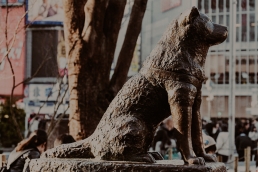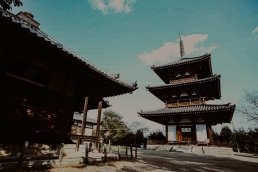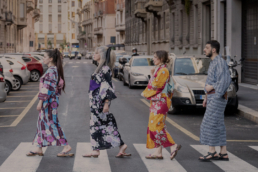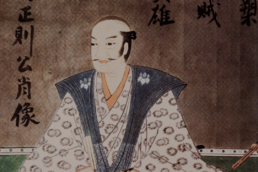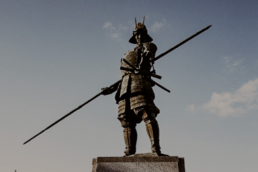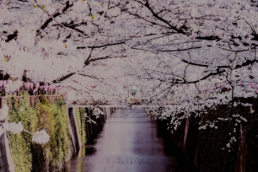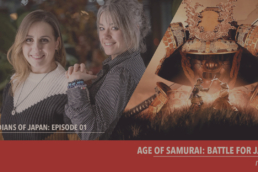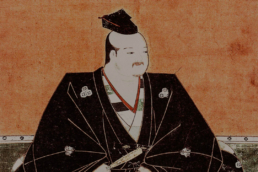Ten things you don't know about Hachiko
Everyone, but really everyone, knows the story of the faithful Hachiko, the dog that in the 30's moved the hearts of the whole world for his deep fidelity, but not everyone knows some details about this sweet dog whose symbolic statue stands in Shibuya.
10 things you don't know about Hachiko
Author: Sara

photo credits: lastampa.it
1- The Origins
The beautiful Akita-inu was born in 1923 in Odate in Akita Prefecture (hence the breed name, "Akita dog") and was purchased by the scientist Hidesaburo Ueno who named him Hachi, "8". Right in Odate, in front of the station, there is another statue of Hachi a shrine and the Akitainu Hozonkai Museum.

photo credits: keblog.it
2- Love overcomes evil
.
When Ueno died in 1925, Hachi found a new home with the scientist's former gardener, Kikuzaburo Kobayashi in Tomigaya, not far from Shibuya. Every day the faithful dog went to Shibuya station to wait for the return of Ueno, but for 10 years this "walk" was not always quiet: Hachiko was mistreated and beaten several times by pedestrians, children and people without any humanity. Shameful, isn't it?

photo credits: greenme.it
3- Hachi becomes Hachiko
.
In 1932, the president of the Nihon Ken Hozonkai, an association for the preservation of Japanese dogs, Hirokichi Saito, learned of Hachi's history and wrote an article recounting the vicissitudes and mistreatment suffered by this faithful dog, transforming it in a short time into a symbol. It was at this point that the suffix "ko" was added to Hachi's name to show respect for his devotion and loyalty.
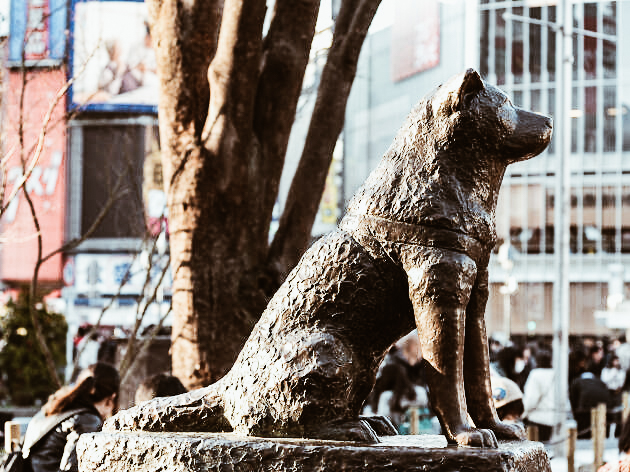
photo credits: hotcorn.com
4- The Honorary Statue
Teru Ando, Saito's acquaintance, sculpted the famous Hachiko statue (while the dog was still alive!) which was unveiled in 1934. Before this happened several swindlers tried to get money out of him claiming to be the creators of the statue! There is really no limit to human greed...

photo credits: japantravel.com
5- The Merger of the Statues
.
World War II spared nothing, not even the Hachiko statues. The metal with which they were made had to be used "for the good of the war" and so they were melted down.
At the end of the Pacific War Ando's son, Takeshi, built the current statue in Shibuya. The one at Odate Station was also rebuilt in 1967.
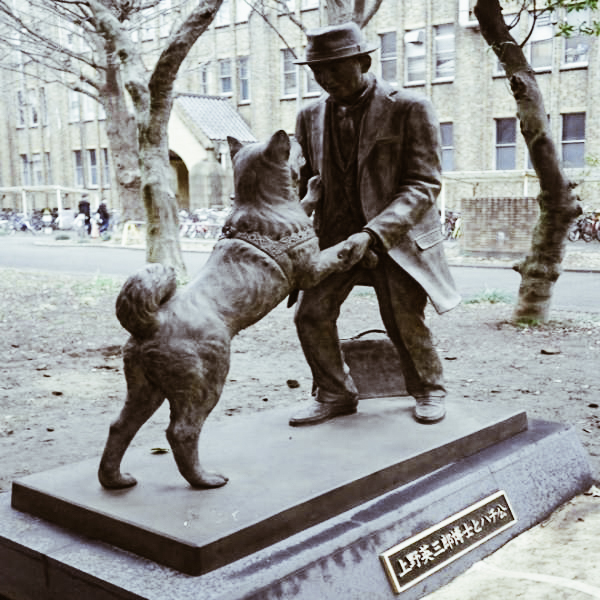
photo credits: animalpedia.it
6- Hachiko and Ueno forever together
.
So far we have always talked about the statues dedicated to the puppy, but there is another, beautiful one that brings together Hachiko and his master. It was built 80 years after Hachiko's death, when the University of Tokyo decided to pay tribute to the two protagonists of the sad story. Thanks to donations from individuals and companies, over 10 million yen made the reunion between the dog and his master possible. Today the statue stands on the campus of the University of Tokyo, right next to Ueno Park.
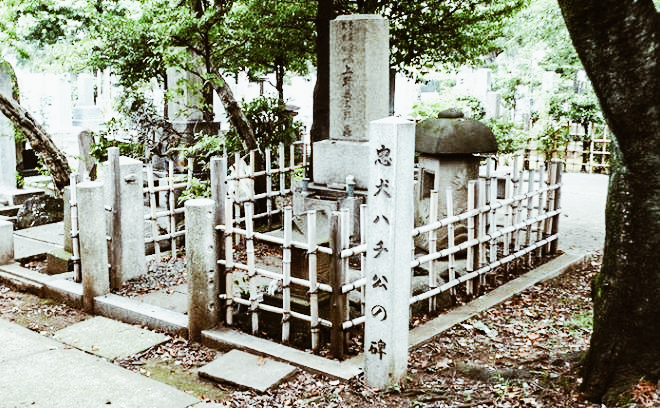
photo credits: womanuntamed.com
7- A Cemetery Full of Charm
I guess I'm one of the few people who like to visit cemeteries, and the Aoyama Cemetery, dating back to 1872, is definitely one of the most beautiful: near the Gaienmae and Aoyama Itchome stations, it stretches out like a huge park and is home to many famous people whose tombstones rise up to reveal a unique architecture. Of course Ueno lies right here and next to his grave there is a monument erected immediately after the death of Hachiko in 1935.

photo credits: wikimedia.org
8- Between the macabre and science
.
I would almost call this point disgusting, but if you have the courage (and the stomach) of iron then know that it is possible to observe the internal organs of Hachiko preserved in sample bottles at the museum of the archives of the Faculty of Agriculture of the University of Tokyo, near Ueno Park. Various autopsies performed between 1935 and 2010 had found infestations of parasitic diseases and, finally, cancer, the real cause of Hachi's death. At the National Museum of Nature and Science there is also a taxidermied Hachiko with the original fur of the dog......

photo credits: timeout.com
9- The Protectors of Tokyo
The statue of samurai Saigo Takamori with his faithful Tsun also stands in Ueno Park. Tsun and Hachiko quickly became a symbol for the Japanese and declared the "protectors of Tokyo and the Japanese economy."

photo credits: ilgiornale.it
10- Richard Gere as Ueno?
.
I'm sure everyone (or almost everyone) has seen the movie "Hachiko - Your Best Friend" (Original title: "Hachi: A Dog's Tale") , but have you stopped to think that this 2009 film is set in the United States? The story is nonetheless heartbreaking and beautiful, but it fails to bring Japanese culture to light in the way that the original 1987 film, "Hachiko Monogatari" does.
Nara, the capital of Buddhism in Japan
Japan, like Italy, has many tourist destinations and among them are the seven temples of Nara, a destination rich in history and culture.
The 7 Temples of Nara, the capital of Buddhism
Autore: Sara

Those who approach the culture of the Rising Sun for the first time are led to believe that Buddhism has always been a strictly Japanese philosophy, also thanks to the numerous temples scattered throughout the country. In reality, few people know that it was a Korean king who "exported" this religion to Japan! It all began when the prefecture of Nara was the center of politics, culture and economy of the country. The Japanese people were purely Shintoist, that is a follower of "Shinto" (神道): a polytheistic religion of animist type that revolves around the existence of many Kami ("gods", "spirits") that are believed to inhabit all things. In 552, King Seond of Baekje, a kingdom in the southwest of the Korean peninsula, brought to the Japanese court a statue of Shakyamuni (historical Buddha) and many satras. The emperor of the time, Kimmei, was attracted and slowly Buddhism established itself as the new state religion.
Nara thus became Nanto Shichi Daiji (南都七大寺), the capital of Buddhist temples built by imperial order, now a world heritage site, and includes:
- Horyuji(法隆寺)
- Houkiji (法起寺)
- Todaiji(東大寺)
- Kofukuji(興福寺)
- Gangoji (元興寺)
- Yakushiji (薬師寺)
- Toshodaiji (唐招提寺)
The Seven Temples of Nara
.
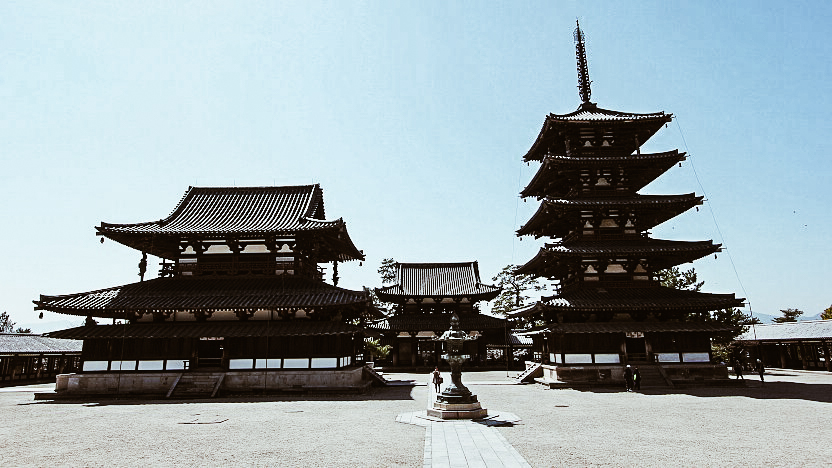
photo credits: https://www.japan-guide.com
Horyuji
Horyuji Temple is the first site to be designated a UNESCO World Heritage Site in Japan. Founded in 607 by Prince Shotoku at the behest of his father, Emperor Yomei, it was rebuilt in 670 following a fire that almost burned it down, and today is considered the cradle of Japanese Buddhism. The area over which the large temple complex stretches can be divided into the west side, Saiin garan (西院伽藍, where the five-story pagoda, golden hall, corridor and internal portal are located) and the east side, Toin garan (東院伽藍, where the octagonal Yumedono (夢殿, the hall of visions) stands.
Official Site: http://www.horyuji.or.jp/assets/images/pdf/english.pdf
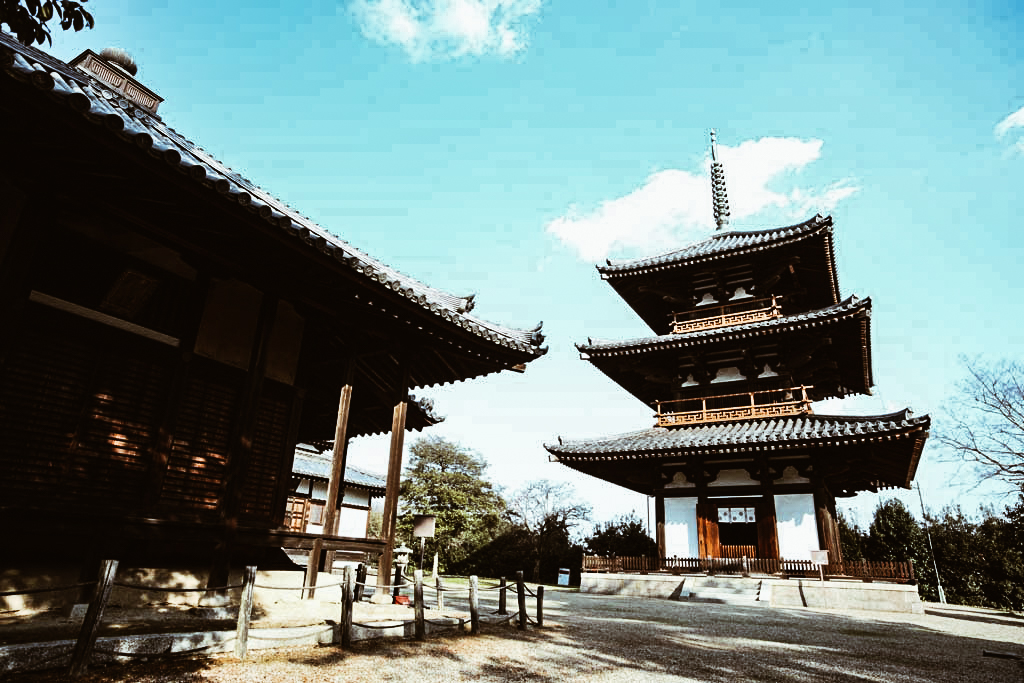
photo credits: masterpiece-of-japanese-culture.com
Houkiji
This temple with multiple identities (it is in fact also known as Okamoto-dera 岡本寺, Okamotoniji 岡本尼寺, Ikejiri-dera 池後寺 and Ikejiriniji 池後尼寺) is located just under 2 km from Horyuji. It was originally the palace of Shotoku Taishi's family, but before his death he ordered his son Yamashirono-ooenoo to rebuild it in the form of a temple. Houkiji consists of a main hall and a 3-story pagoda, about 23 meters high: the largest and oldest of its kind in Japan (it was built in 685). A symbol of this temple is undoubtedly the 11-headed wooden Kannon and the bronze Bosatsu (both gods of compassion).
Official Site: http://www.horyuji.or.jp/assets/images/pdf/english.pdf

photo credits: shoreexcursions.asia
Todaiji
Todaiji was founded by Emperor Shomu in 752, with the sole purpose of housing the statue of the Great Buddha in the Great Hall (Daibutsuden). After 7 long years of construction, the temple was burned down as a result of war in 1180 and continued to suffer the consequences of conflict until 1567. Restored each time, the temple's current form dates back to 1709 and its seated Buddha represents Vairocana and is flanked by two Bodhisattvas. The temple's grounds extend across almost the entire northern part of Nara National Park, so it is not uncommon to come across the famous deer seeking attention!
Official Site: http://www.todaiji.or.jp/english/index.html
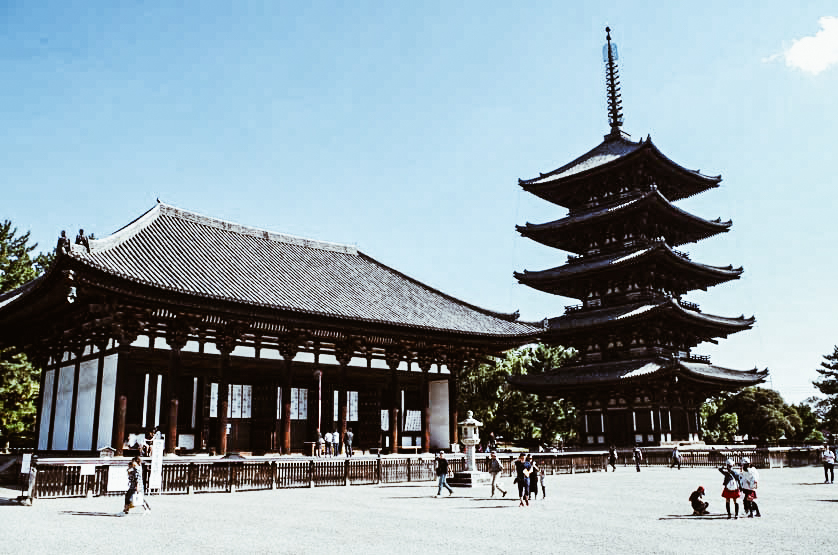
photo credits: japanvisitor.com
Kofukuji
Kofukuji was originally the temple of the powerful Fujiwara clan and one of the main temples of the Hosso (法相宗) sect, one of the six sects of Nanto. The temple consists of several buildings of important historical value and as many as two pagodas: one five-story and one three-story, which unfortunately cannot be visited. To make up for this lack, however, there is the National Treasure Museum where you can admire the statue of Ashura and the bronze head of Buddha.
Official Site: https://www.kohfukuji.com/english.html
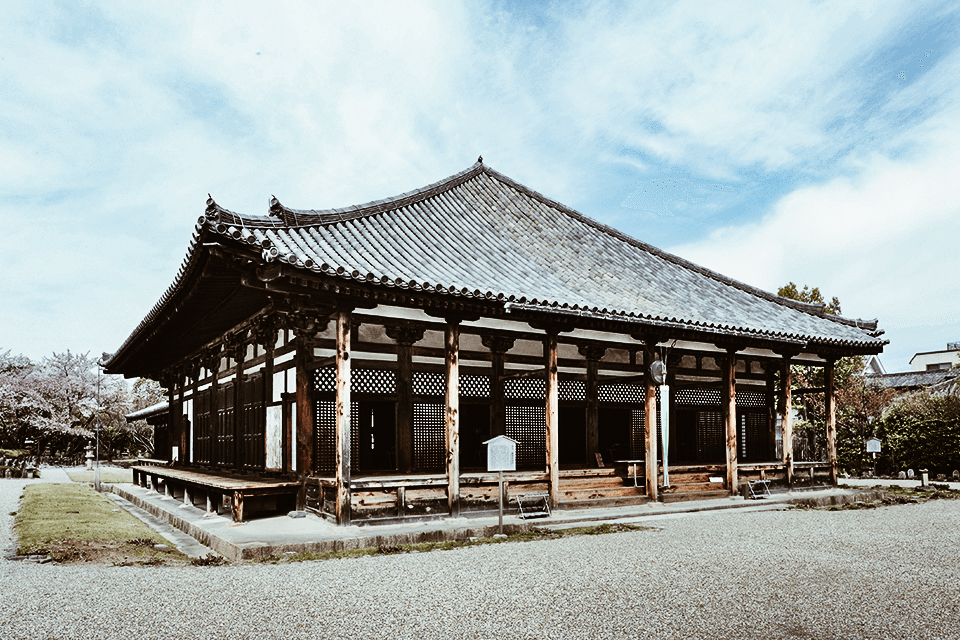
photo credits: kintetsu.co.jp
Gangoji
Founded by Soga no Umako, Gangoji is among the oldest temples in Japan, having been moved from Asuka to Nara in 718. Almost as a gloomy tradition, this temple also suffered the wrath of nature and the devastation of fire and in 1451 almost the entire structure was destroyed and it was no longer possible to recover the ancient splendor of Gangoji except for the Zenshitsu Hall, located at the back, the only original survivor.
Official Site: https://gangoji-tera.or.jp/

photo credits: japan-guide.com/
Yakushiji
Esattamente come Kofukuji, anche Yakushiji è il tempio principale della setta Hosso del buddismo. Fu costruito dall’imperatore Tenmu per sua moglie nel 680. Come ogni tempio, anche questa volta troviamo una grande statua del Buddha: in questo caso Yakushi-Nyorai possiede il potere della guarigione ed è in grado di dare conforto. Inoltre Yakushiji possiede due pagode, una sala dorata ed una collezione di oggetti d'arte buddista, tra cui una Triade Yakushi, un Kannon-Sho e dipinti di grande pregio
Sito Ufficiale: http://www.nara-yakushiji.com/
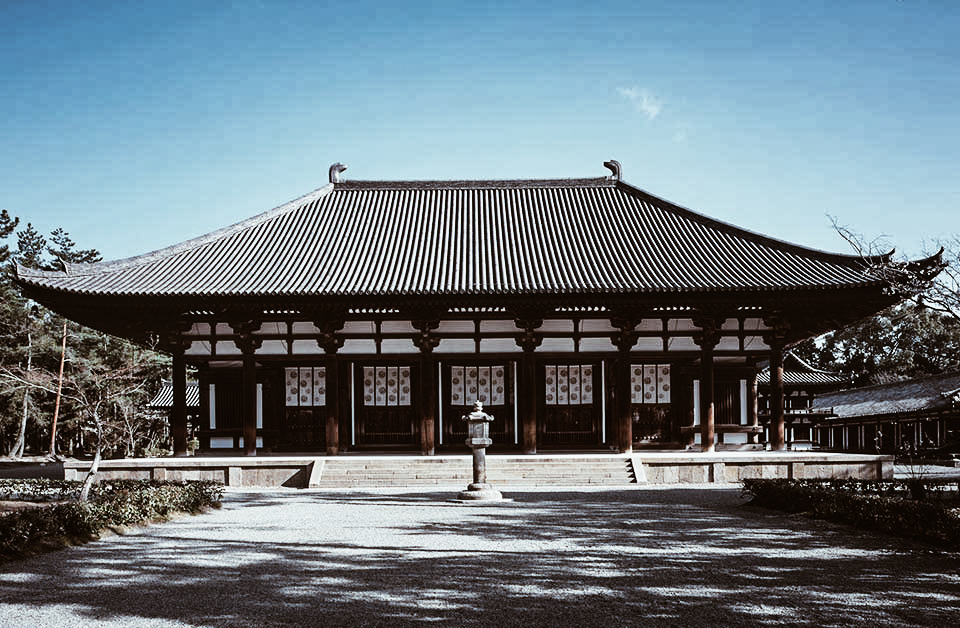
photo credits: toshodaiji.jp/
Toshodaiji
Toshodaiji was the first temple founded in 759 by a Chinese priest, Ganjin, who was sent by the emperor for the purpose of teaching priests and improving Buddhism in Japan. His teachings had a great influence for the country and today it is the main temple of the Rishu (律宗) sect. The main hall, Kondo, contains 9 statues of Buddha!
Official website: https://www.toshodaiji.jp/english/index.html
7 Temples, 7 fascinating wonders dedicated to the care of the soul: although they may seem extremely similar to each other, each building is characterized by unique and precious elements to discover and admire! How about dedicating some of your time to walk around Nara to discover these devout places? Have you already been there? Let us know your impressions and emotions!
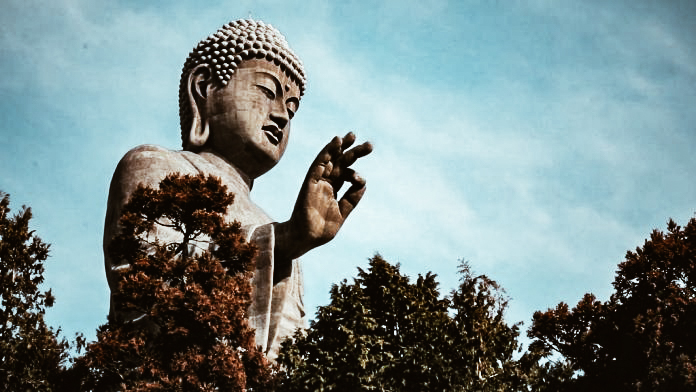
photo credits: thejapanesedreams.com
Here comes the Kimono Experience at TENOHA Milano
Here comes the KIMONO EXPERIENCE with Giappone In Italia, Milano Kimono and TENOHA Milano!
The Giappone In Italia Association has created a unique experience in collaboration with Milano Kimono and TENOHA Milano, we are talking about the KIMONO EXPERIENCE!
Feel the real Japan with the Kimono Experience
Author: SaiKaiAngel
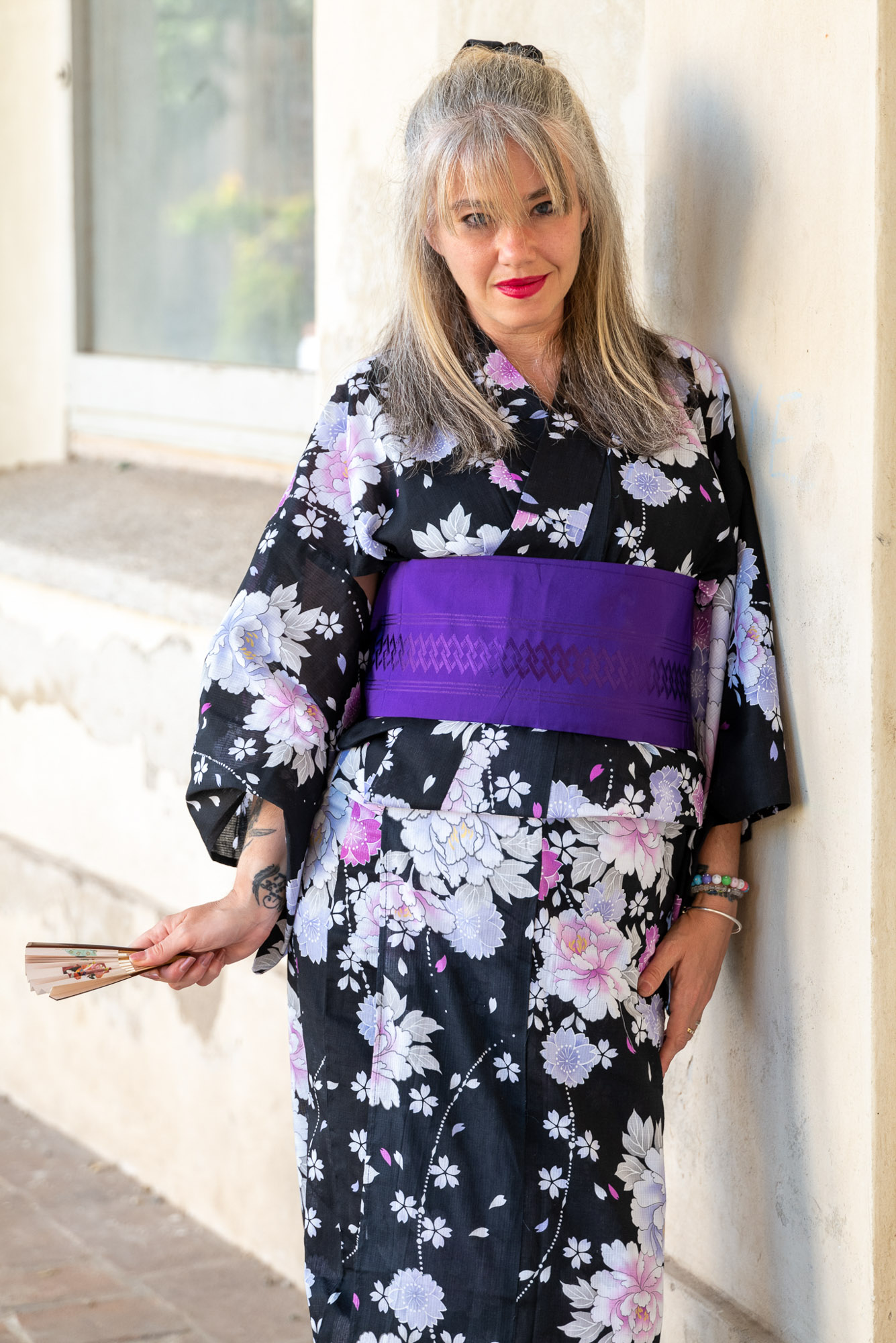
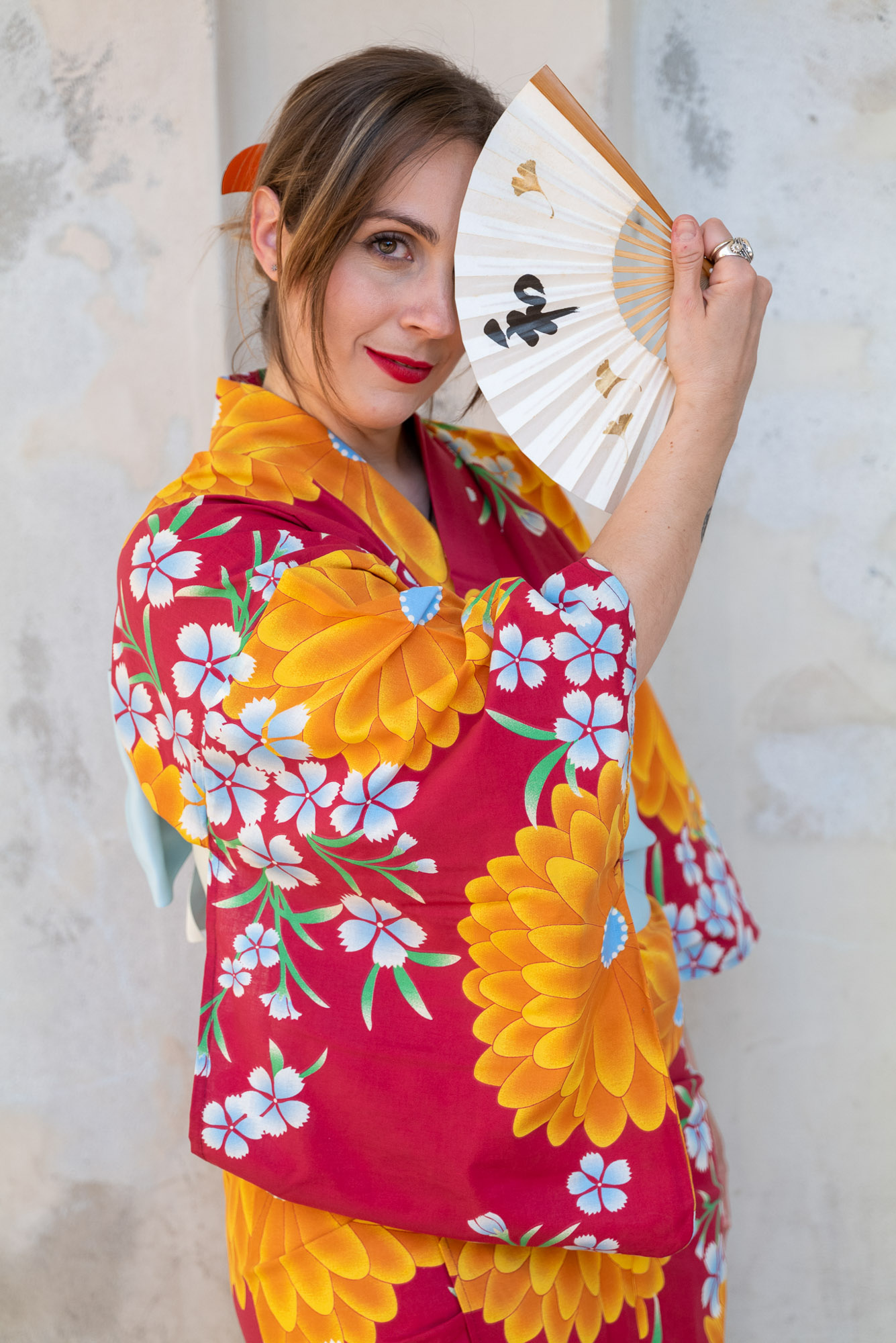
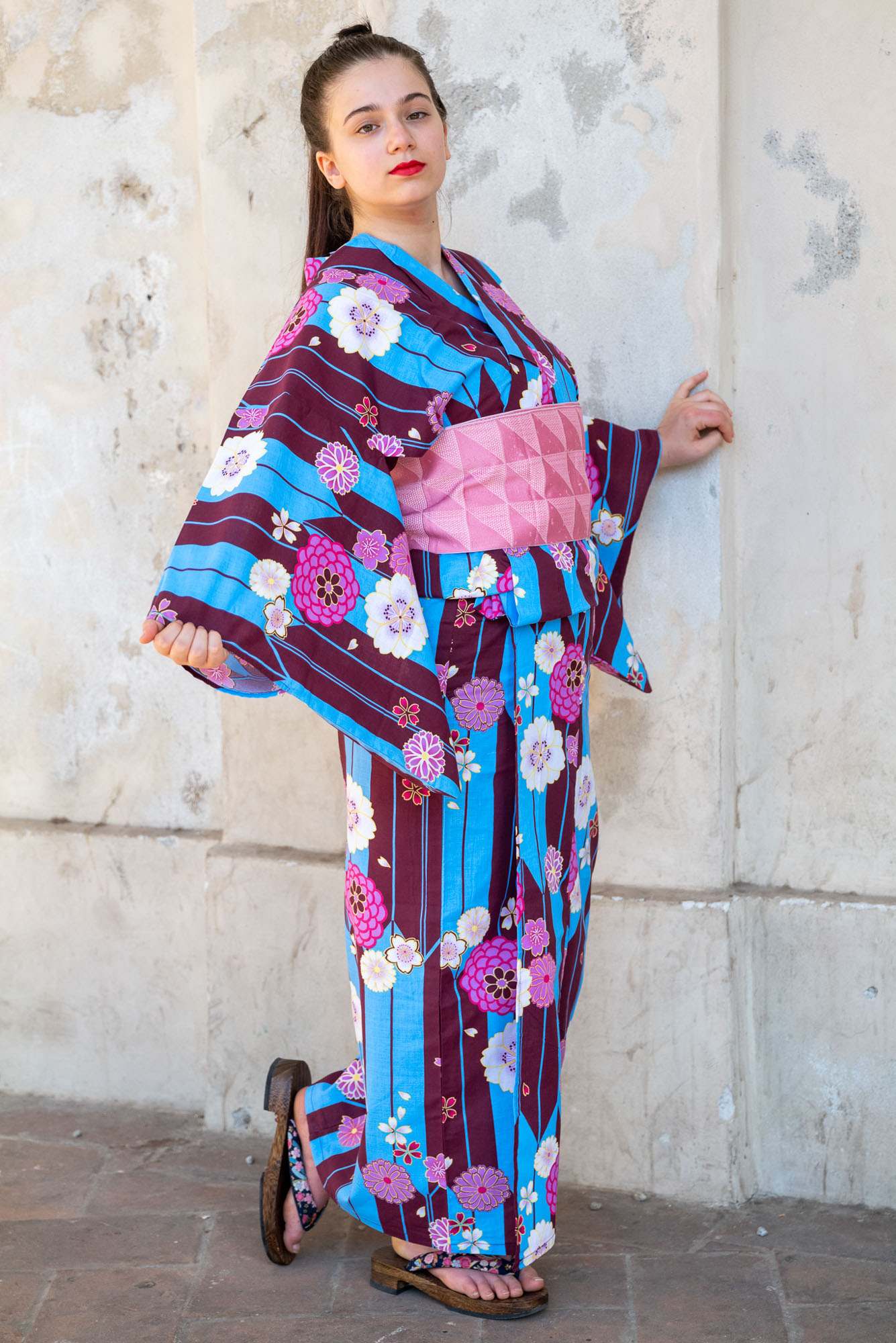
Do you feel like spending some unique, timeless moments? At a time when everything is hectic, why don’t we take a moment for ourselves? Without commitments, stress or confusion? Let's immerse ourselves in the love of Japan and do it in the best possible way! Have you ever wondered "But how would I look in a yukata or a kimono?" I think so, at least, I've asked myself that many times and finally managed to see myself in traditional Japanese dress! As you know, Giappone In Italia Association, TENOHA Milano and Japan Italy Bridge are working with a common focus: building a bridge between Japan and Italy by promoting Japanese culture here.
An absolutely special experience that will allow you to feel in Japan. If you can't take the plane, how can you experience Japan? You can do it as always in the corner of Japan here in Italy, TENOHA Milano! Not only that, from 15 to 30 June, you can enjoy the "KIMONO EXPERIENCE"! What is it about exactly?
What is it?
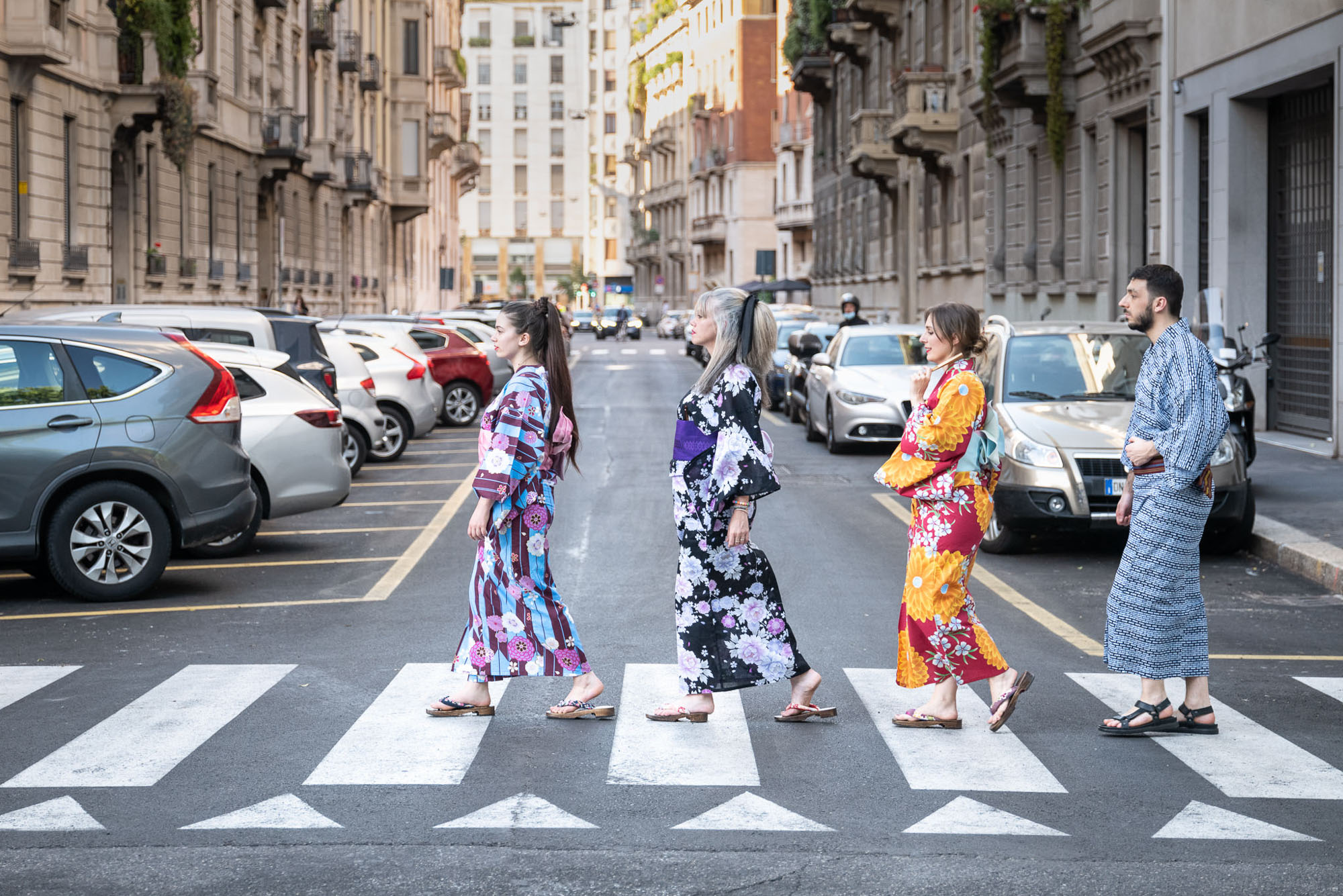
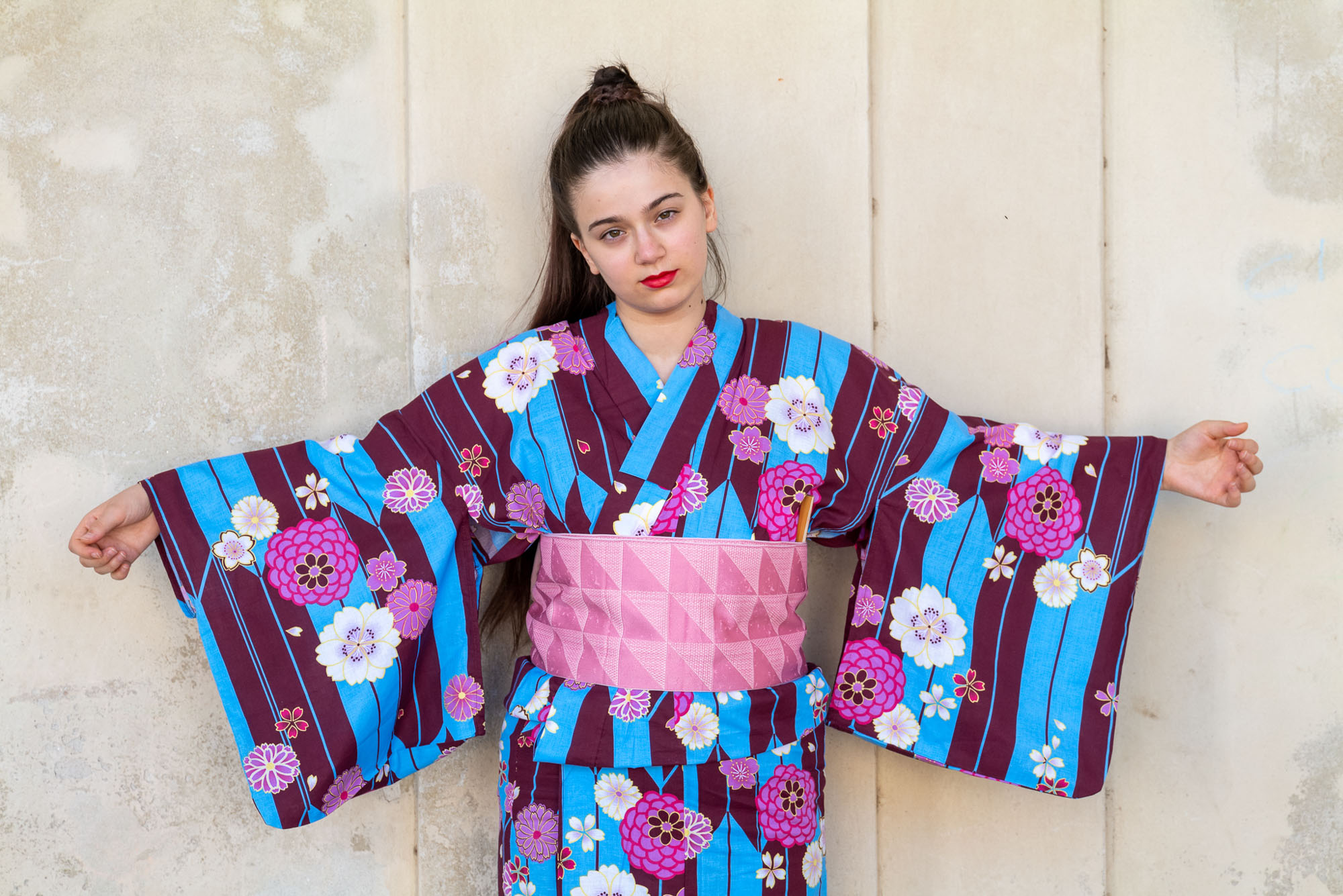
The KIMONO EXPERIENCE is an exhibition at TENOHA Milano from 15 to 30 June, featuring the most beautiful kimonos and photos by Alberto Moro, President of Japan in Italy and author of the book 'Il mio Giappone'. You will find photos of people who wanted to wear kimonos in the streets of Milan even without being Japanese! This is the aim of KIMONO EXPERIENCE, to make non-Japanese people live the emotion of the Rising Sun, not only around, but also on them. Yes, because if you book your place, you can have the joy of wearing a yukata and being photographed by none other than the President of Japan in Italy, Alberto Moro, who is, as you know, also a famous photographer.
Imagine yourself in the Japanese atmosphere, wrapped up in a yukata (kimono summer version) that the dressmaker Yurie Sugiyama will have you put on, photographed by Alberto Moro in the incredible and Japanese TENOHA Milano. A dream? No! A reality that is waiting for you!
You can visit the exhibition from 15 to 30 June, from 10 a.m. to 8 p.m., in the TENOHA Milano pop-up space at Via Vigevano 18.
If you would like to dress up and have your photo taken in yukata, remember that the dress-up teacher Yurie Sugiyama will be available from 17 to 20 and from 24 to 27 June, from 10.30 am to 1 pm and from 3 to 6 pm. Although the fitting will be free of charge, in the form to be filled in below, you will be asked for a booking deposit which will be returned when you show up at the KIMONO EXPERIENCE!
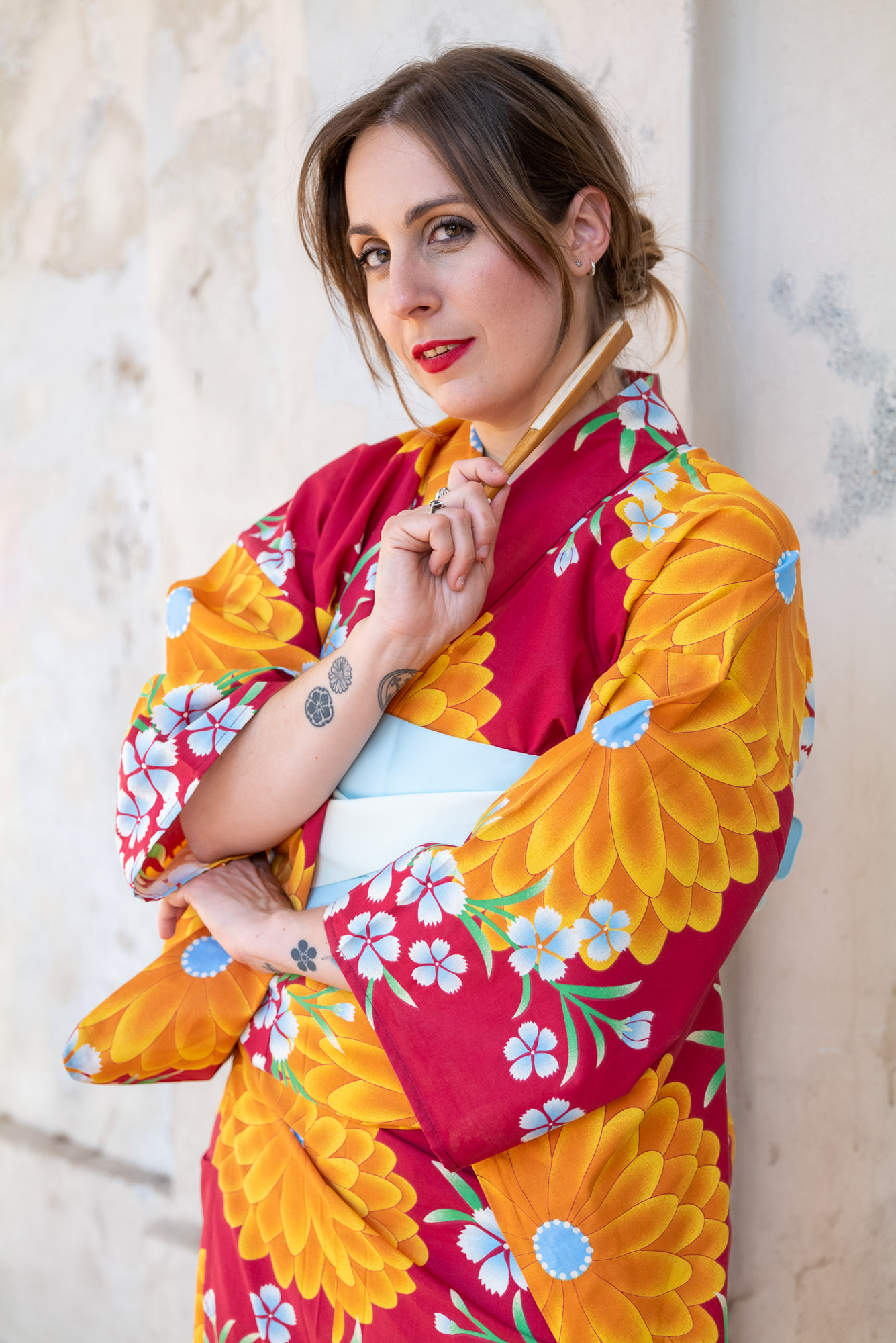
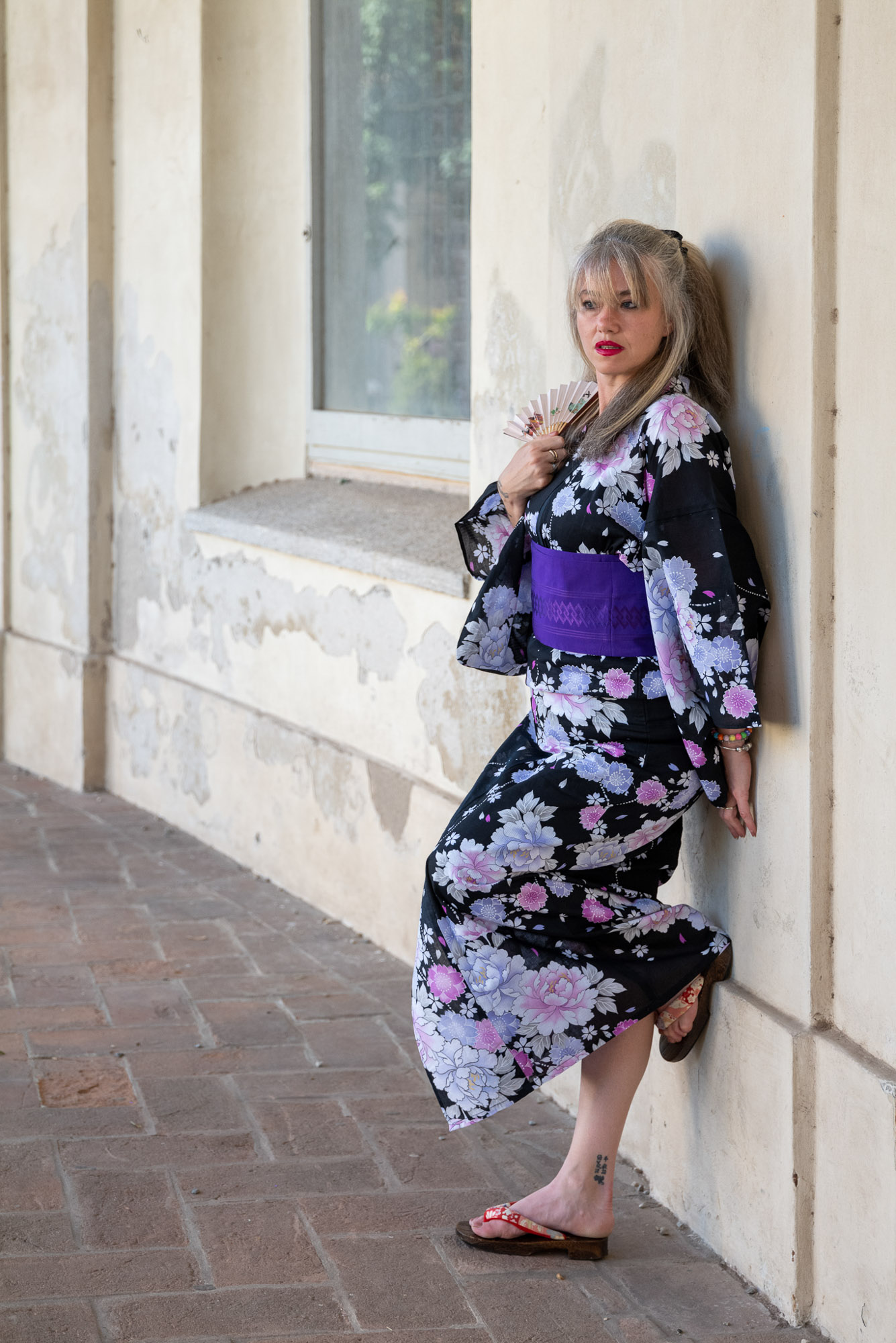
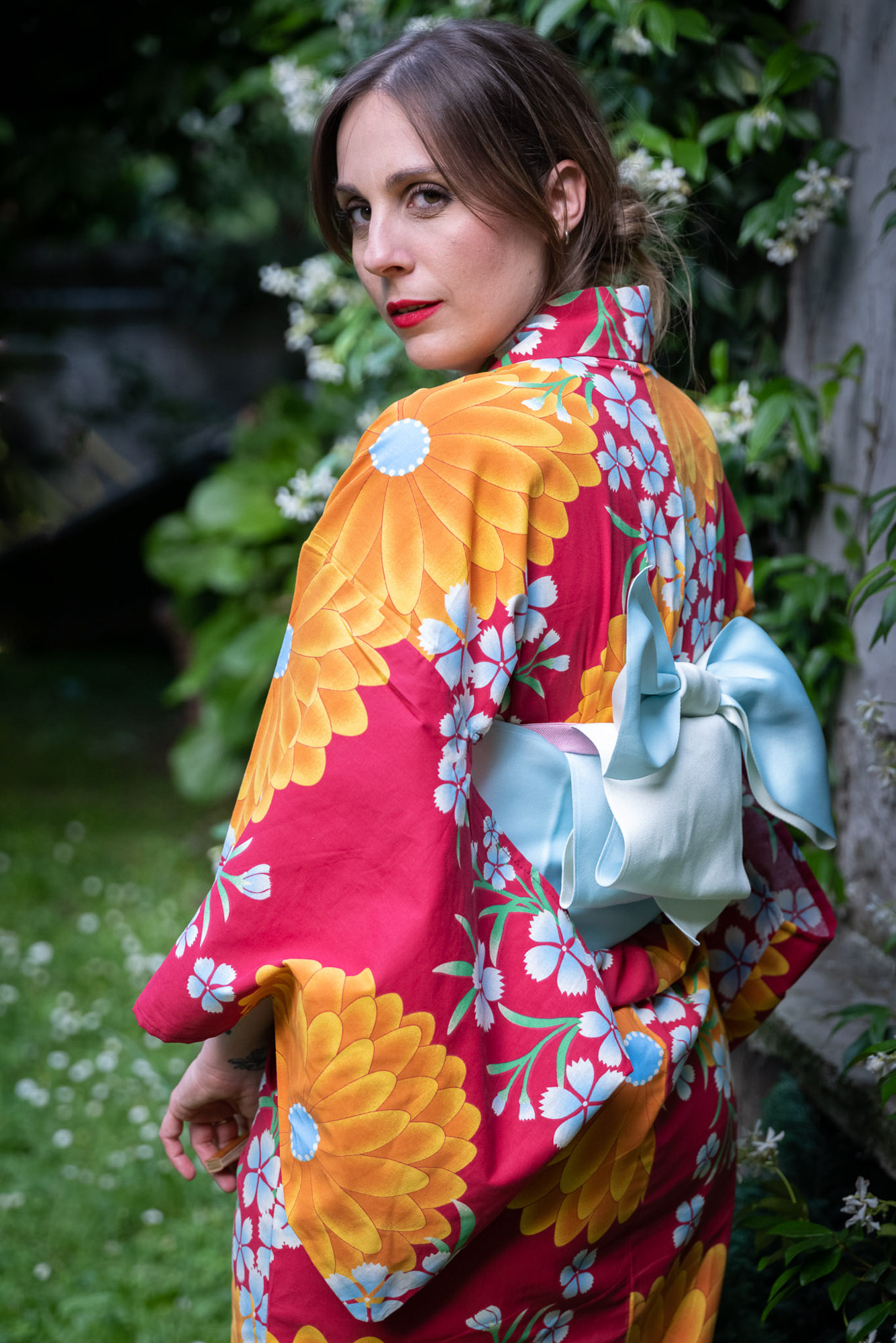
Not only that! If you wish, you can buy your photo in kimono as a unique and unrepeatable souvenir of the day. They will surely ask you when you flew to Japan, because these are moments that can hardly be repeated here in Italy.
KIMONO EXPERIENCE, un’esperienza da non perdere, per portare nuovamente il Giappone In Italia, come recita il nome dell’Associazione che l’ha creata.
Obviously we at Japan Italy Bridge look forward to seeing you there!
>> BOOK NOW YOUR KIMONO EXPERIENCE! <<
Subject to availability.
photo credits: Alberto Moro, Presidente Associazione Giappone in Italia
Japan History: Fukushima Masanori
Fukushima Masanori (1561 - August 26, 1624), whose name was originally Ichimatsu, was born in Owari Province.
Fukushima Masanori, one of the Seven Spears of Shizugatake
Author: SaiKaiAngel
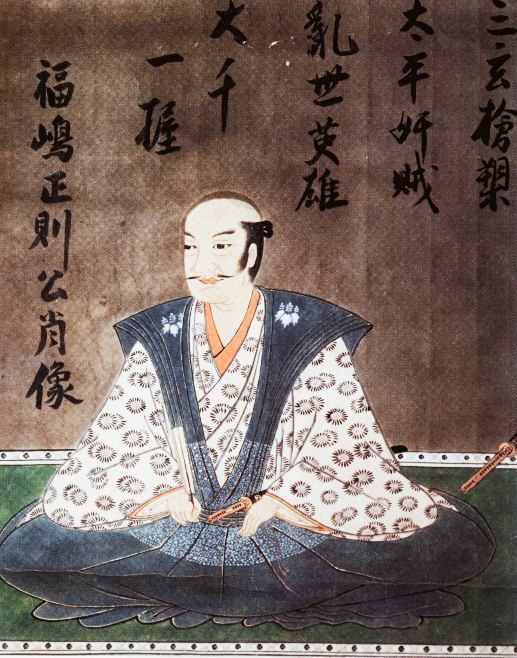
photo credit: wikipedia.org
Son of Fukushima Masanobu, Fukushima Masanori was a Japanese general and daimyō in the service of the Tokugawa, also famous for being one of the Seven Spears of Shizugatake. It is also said that he may have been a cousin of Toyotomi Hideyoshi. Masanori stormed Miki Castle in Harima Province and, during the Battle of Shizugatake in 1583, defeated Haigo Gozaemon and had the honour of taking the first head, that of the enemy general Ogasato Ieyoshi.
Fukushima Masanori took part in many of Hideyoshi's campaigns; it was after the Kyūshū campaign (1586-1587) that he became daimyō, receiving the fief of Imabari in Iyo province; shortly afterwards he took part in the Japanese invasions of Korea (1592-1598) and distinguished himself once more during the Battle of Chungju.
Following his involvement in the Korean campaign, Masanori was involved in the search for Toyotomi Hidetsugu. He led 10,000 men in 1595, surrounded the Seiganji temple on Mount Kōya and waited for Hidetsugu to commit suicide. On Hidetsugu's death, Masanori received Hidetsugu's former fief of Kiyosu in Owari province.
Being hostile to Ishida Mitsunari, Fukushima Masanori came into sympathy with Tokugawa Ieyasu; Ishida burned Masanori's castle on a pretext and during the Battle of Sekigahara launched the first attack on Ukita's troops, remaining in the front line throughout. Having won the battle and captured Ishida, Masanori beheaded the enemy daimyō in Kyoto along with Anko and Konishi. Masanori received the fief of Hiroshima in Aki, but Ieyasu never fully trusted Masanori, so he ordered him to rebuild the Nagoya castle so that he could spend some of his income.
At that point, Masanori asked to take part in the siege of Osaka (1614-15), but was forced to remain in Edo. The new Shōgun, Hidetada, trusted Masanori even less and, after Ieyasu's death, accused him of misrule and transferred him to the fief of Kawanakajima. Fukushima Masanori's younger brother Masayori had already been deprived of his fief at Yamato in 1615.

Il posto di comando di Fukushima Masanori a Sekigahara
photo credit: samurai-world.com
It seems that his descendants became hatamoto in the service of the Tokugawa shogunate. The hatamoto were samurai under the direct control of the Tokugawa Shogunate in feudal Japan. All three shogunates in Japanese history had direct contacts, only in earlier shogunates they were called gokenin. However, in the Edo period, the hatamoto were the senior vassals of the Tokugawa dynasty and the gokenin were the junior vassals.
Fukushima Masanori owned one of the three great spears of Japan: Nihongo, or also called Nippongo (日本号). Used in the Imperial Palace, the Nihongo was later owned by Masanori Fukushima, and then passed into the hands of Tahei Mori. It was recovered, restored and is now in The Fukuoka City Museum.
Japan History: Chōsokabe Motochika
Chōsokabe Motochika (1538 - 11 July 1599) was a Japanese daimyō of the Sengoku period and was born in Okō Castle in the Nagaoka district of Tosa province. The eldest son of Chōsokabe Kunichika, Chōsokabe Motochika was such a sweet boy that his father was worried about his nature, and it seems he was nicknamed Himewako, "Little Princess", by his vassals.
Chōsokabe Motochika, also known as Himewako
Author: SaiKaiAngel
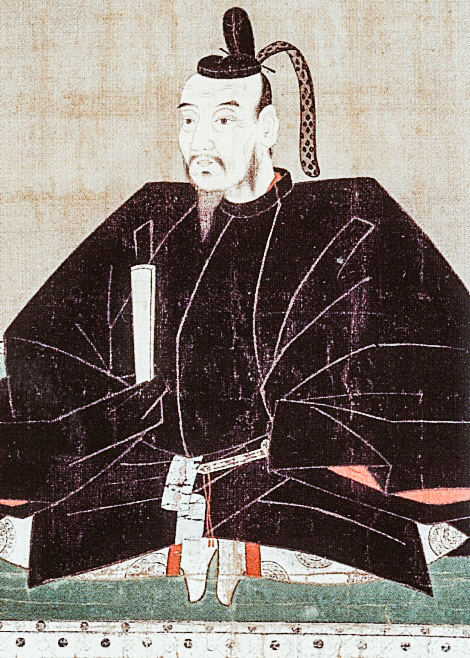
photo credits: wikipedia.org
Despite these concerns, Chōsokabe Motochika proved to be a skilled and brave warrior in his first battle, defeating the Motoyama clan in 1560 at the Battle of Tonomoto. After defeating the Motoyama and forming alliances with local families, Chōsokabe Motochika was able to build his power base on the Kōchi Plain. While remaining loyal to the Ichijō, Motochika with a force of 7000 men marched on the Aki clan, rivals of the Chōsokabe, defeating them in 1569 during the Battle of Yanagare. At that point Chōsokabe Motochika could concentrate on the Ichijō.
During the rule of the Hata district of Tosa, Ichijō Kanesada was a very unpopular leader and because of this, Motochika wasted no time in marching on the Ichijō headquarters in Nakamura and in 1573 Kanesada fled. At that point, the Ōtomo clan provided Kanesada with a fleet and with that he returned, leading an expedition that the Chōsokabe defeated at the Battle of Shimantogawa. At this point Kanesada submitted to the Chōsokabe, who probably had him assassinated in 1585.
Chōsokabe Motochika became the sole ruler of Tosa, and one of the problems the Chōsokabe faced was their own territory. Because of his poverty, he was unable to pay his generals, so he began to look to neighbouring provinces.
The unification of Shikoku
After the conquest of Tosa, Chōsokabe Motochika prepared for an invasion of the province of Iyo, against the lord of that province Kōno Michinao, a daimyō who had been driven from his domain by the Utsunomiya clan, helped only by the Mōri clan. But at this time the Mōri clan was at war with Oda Nobunaga, so they were unable to help Michinao, however the campaign in the Iyo province was not easy.
In 1579 a Chōsokabe army of 7000 men, led by Hisatake Chikanobu, attacked Okamoto Castle, held by Doi Kiyoyoshi in southern Iyo. During this siege, Chikanobu was killed and his army defeated. Motochika returned the following year with some 30,000 men to Iyo and forced Michinao to flee to Bungo province. With the Mōri and Ōtomo engaged on other fronts, Motochika was free to continue his conquest of the island and in 1582 was able to continue his raids on the Awa province to defeat the Sogo clan, giving him control of the island in 1583.
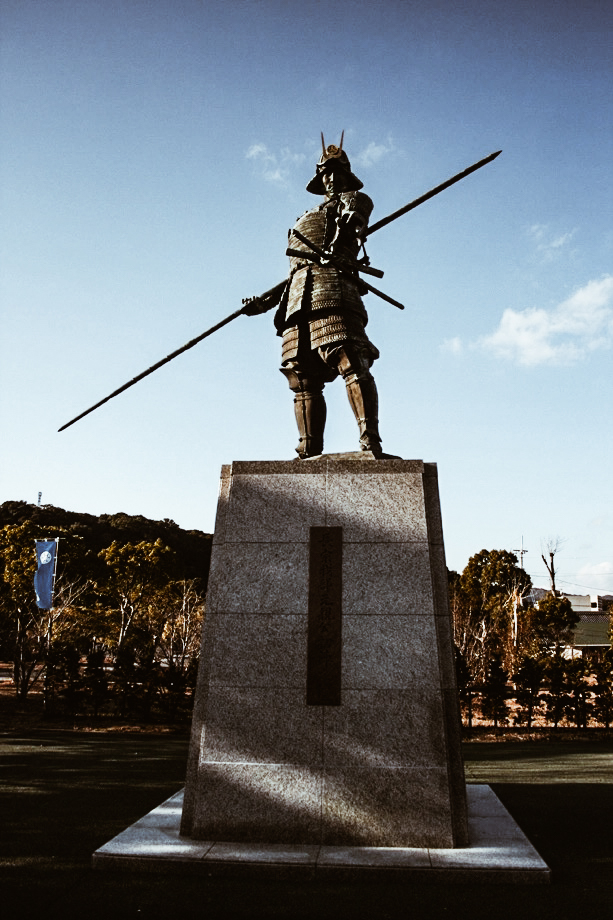
photo credits: mvbennett.wordpress.com
In 1579 Chōsokabe Motochika entered into communication with Nobunaga who seemed to have praised him, although in private he referred to him as a bat on a birdless island and planned to conquer Shikoku in the future, planning to give it to his son Nobutaka. This did not happen, due to Nobunaga's death in 1582.
Involved in the ensuing dispute between Toyotomi Hideyoshi and Tokugawa Ieyasu the following year, he promised Tokugawa his support, although he made no direct moves to that end. Hideyoshi instead sent Sengoku Hidehisa to block any interference from Motochika. The Komaki campaign between Hideyoshi and Ieyasu ended in a peace treaty, and in 1584 Hideyoshi invaded Shikoku with 30,000 troops from the Môri clan and another 60,000 from Hashiba Hidenaga. Motochika managed to retain control of the Tosa province thanks to the terms decided by Hideyoshi.
Chōsokabe Motochika is remembered both for his 100-article Code of Chōsokabe and for his tenacity in founding a very strong castle-city from Oko to Otazaka and then to Urado. However, the problems caused by Morichika's appointment as heir led to the clan's undoing. After Nobuchika's death in battle, Hideyoshi suggested that Motochika's second son, Chikakazu, be appointed heir.
But when Motochika resigned, he made Morichika, his fourth son, his heir, because he felt Chikakazu was physically incapable of assuming leadership of the family. With this in mind, Chikakazu retired and died of illness in 1587. When Chōsokabe Motochika was called to Hideyoshi's invasion of Kyūshū, he and Sengoku Hidehisa were called in.
Their mission was to raise the siege of the Ōtomi clan. Despite the wise advice of Chōsokabe Motochika, generals Ōtomo and Sengoku did not adopt a defensive position and attacked the forces of the Shimazu clan at the Battle of Hetsugigawa, defeating the allied troops, but at the same time Nobuchika, Motochika's heir, died. At that point Toyotomi Hideyoshi praised Motochika's thinking and offered him Ōsumi as compensation for his loss, but this was refused.
In 1590 Motochika led a naval contingent in the siege of Odawara and in 1592 commanded 3000 soldiers in the invasion of Korea. On his return from Korea he retired to Fushimi, became a monk and died on 11 July 1599.
Sakura, an in-depth look at the flower symbol of Japan
We continue our series of in-depth articles dedicated to the Japanese culture and today we talk about Sakura, the flower symbol of the Rising Sun. "The perfect flower is a rare thing. One could spend a lifetime looking for it, and it would not be a wasted life."
Sakura 桜 Symbolic flower of Japan
Guest Author: Flavia
This is how Ken Watanabe began in a scene from the famous film 'The Last Samurai' (2003) as the rebel samurai Katsumoto, against the backdrop of a beautiful Japanese garden. How could we not remember this scene from the film which, despite some historical inaccuracies, is able to give us moments like this. Surrounded by splendid trees in bloom, Katsumoto-Watanabe is simply staging the prototype of Japanese aesthetic sensitivity towards nature. In this case, towards flowers. But here we are talking about one flower in particular... the cherry blossom, an undisputed object of age-old admiration: the Sakura (桜 - さくら).
We are all familiar with cherry blossoms: their beauty is obvious, admiring them a natural consequence. This, I would say, needs no explanation. We can, however, talk about the particular importance of this delicate little flower in Japan, so much so that it has become a "moral" symbol (the official one is the chrysanthemum).
The term 'Sakura' refers to both the flower and the tree - known as the 'Japanese cherry tree' - a type of cherry tree characteristic of the Far East. There are about a hundred varieties of Sakura in Japan, including the big cities. But the most common are the Yamazakura and especially the (Somei-) Yoshino, with its typical pale pink-white colour, which has been admired by the Japanese for hundreds of springs.
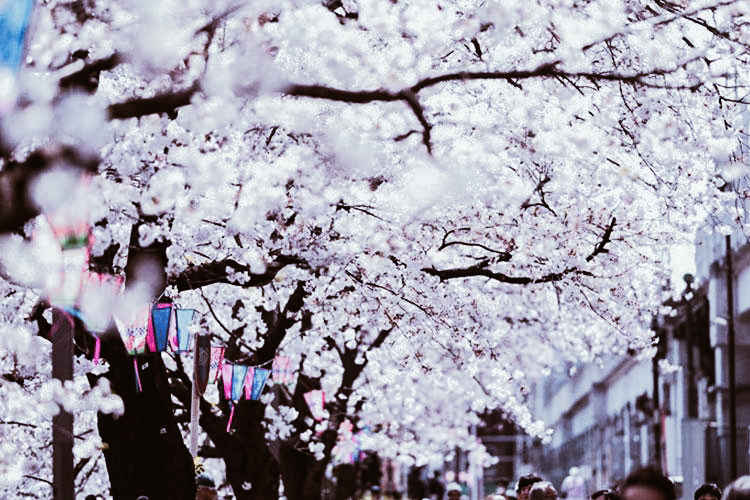
photo credits: japan.stripes.com
The Sakura is an institution in Japan, with its own special symbolism and deep meaning. It appears on the famous 100 yen coin and frames Fuji san, Japan's other great symbol, on the back of the current 1000 yen note. It is so popular that the National Meteorological Agency issues a special Sakura Zensen ( 桜前線 ) bulletin every year to update on the status of the flowering. The media informs the population daily about the best spots, so that they can adjust for the beloved Hanami (flower-gazing) activity, deciding where and what variety of Sakura to see.
Flowering proceeds from south to north, as the climate is milder in southern areas. So if you arrive in Japan when the flowering has already passed in the centre-south, look at the calendar, you might still be in time to catch them in Hokkaidō!
Mankai 🌸 Flowering
The average flowering time varies according to geographical location, but in any case it is short: a few days, maximum ten days. It starts in Okinawa, around the end of January, gradually moving northwards with the last buds opening around mid-May in Hokkaidō. This is the approximate time period. Bad weather, disturbances or sudden changes in temperature can obviously affect the duration of flowering, given the extreme delicacy of the little flower. It all depends on the climate and the year: it can happen that the flowers bloom a little earlier or later, or that the blooming is interrupted by a sudden change in climate. The time of the flowering boom is known as Mankai (満開), which in fact means 'full opening'.
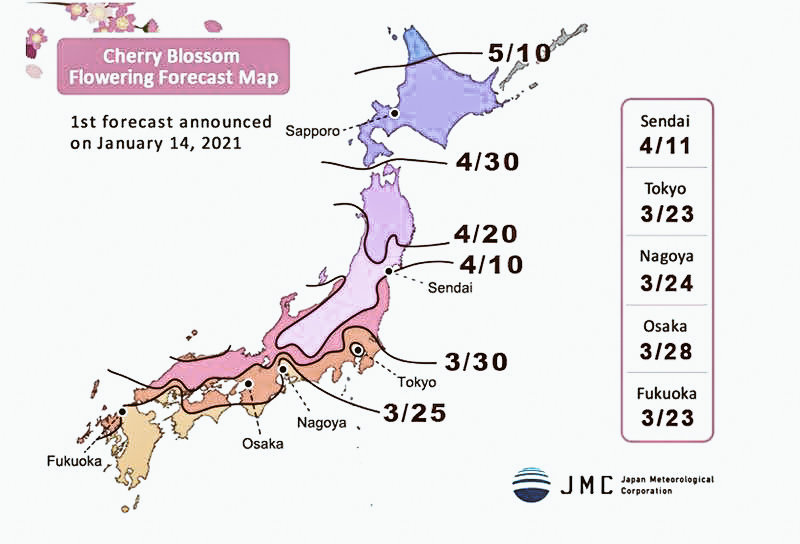
photo credits: japan.stripes.com
As mentioned above, most cherry trees are of the Somei-Yoshino variety, but there are over a hundred species. Some are even capable of producing edible fruit. Of the criteria for distinguishing between the different types, the most immediate is undoubtedly the number of petals, which can be ten, twenty or even more. The most common are the classic five-petalled Sakura, both wild and cultivated.
🌸 Types of Sakura
But let's look at some examples of more unusual cherry trees. In addition to Somei-Yoshino, the most cultivated and popular, we can find:
- Yama-zakura (山桜), the 'Mountain Cherry'. Very popular, it ranks right after Somei-Yoshino in terms of popularity. It has large pink buds and five petals.
- Fuyu-zakura (冬桜), or "Winter Sakura". As the name suggests, it is a cherry tree that begins to blossom in autumn and continues in winter, although not continuously.
- Yae-zakura (八重桜), the "Double Cherry Tree". So called because of its 'reinforced', i.e. very full-bodied, bud with more than five petals. It is associated with the ancient capital Nara (奈良).
- Shidare-zakura (枝垂桜), i.e. "weeping cherry tree" because its branches fall, like a willow, creating a cascade of pink flowers. It is the official flower of the Kyoto prefecture.
- Ichiyō (一葉), "a leaf". It owes its name to a leaf-like pistil that emerges from its centre when fully open. It is one of those that can have 20 to 40 petals.
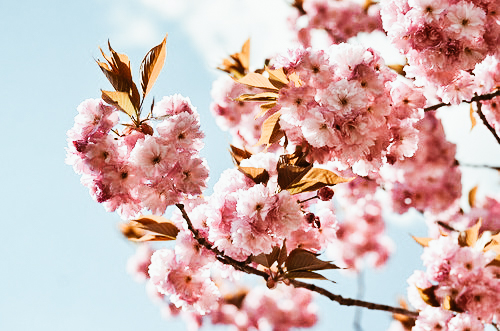
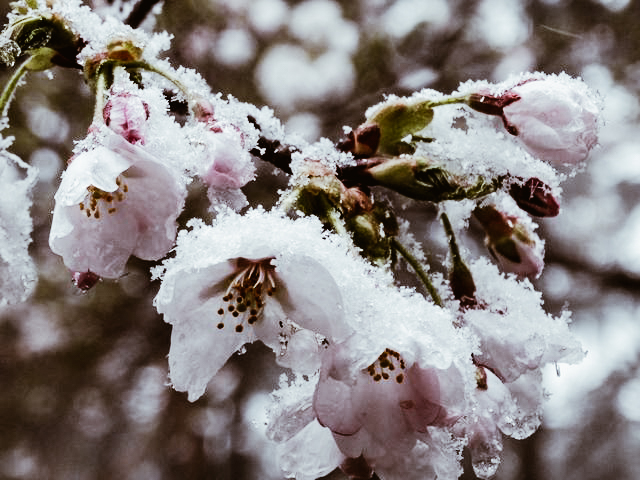

photo credits: Akemi K on Flickr, medigaku.com, Pinterest
Ippon-zakura (一本桜) are defined as all cherry trees planted "in solitude". These include Japan's three great cherry trees, the Sandai-zakura (三大桜). The trio consists of the Jindai-zakura in Yamanashi, the Usuzumi-zakura in Gifu and the Takizakura in Fukushima. Jindai and Usuzumi belong to the Edohigan variety (from which Yoshino is also derived), while Takizakura is a weeping cherry tree. In particular, the Jindai-zakura, located in the Jissōji temple (實相寺), is perhaps the oldest in Japan: it is about two thousand years old and has a circumference of 13 and a half metres!
Spring (春), season of hope
The act of contemplating trees in blossom dates back to the Nara period (8th century). Initially the prerogative of the imperial court of Kyoto, over the centuries it was extended first to the category of samurai and then to the rest of the population. Let us say that in the beginning it was the plum tree (梅-Ume) that was the object of attention. The plum tree represented the link with China, as it originated there. But already in the Heian period (8th-12th centuries), due to the interruption of relations with Middle Earth, the Ume was ousted by the more autochthonous Sakura. From then on, spring-themed poems began to refer to Sakura even only as "flowers" (花-Hana) and the word "Hanami" also became interchangeable with "sakura". Linguistic details, however, are indicative.
Spring (春- Haru) has always been characterised as a symbol of rebirth, of generating power.
In ancient times, the blossoming of cherry trees was associated with prosperity, as it presaged an abundant rice harvest. In order to propitiate a good harvest the following year, the beginning of the planting season was opened with a series of rituals ending with joyful celebrations under the Sakura. In the 18th century, Shōgun Yoshimune Tokugawa further promoted this custom by planting Sakura trees in various areas.
Today, spring is the season for students, graduates and undergraduates, who rely on the auspiciousness of the blossom. April marks the start of the new school year for students, while graduates and many school leavers are preparing to enter the world of work. April also marks the start of the new fiscal year in Japan. In short, the cherry blossom season brings with it some beginnings in that land. Therefore, it is duly celebrated with the Sakura Matsuri (桜祭り) festival.
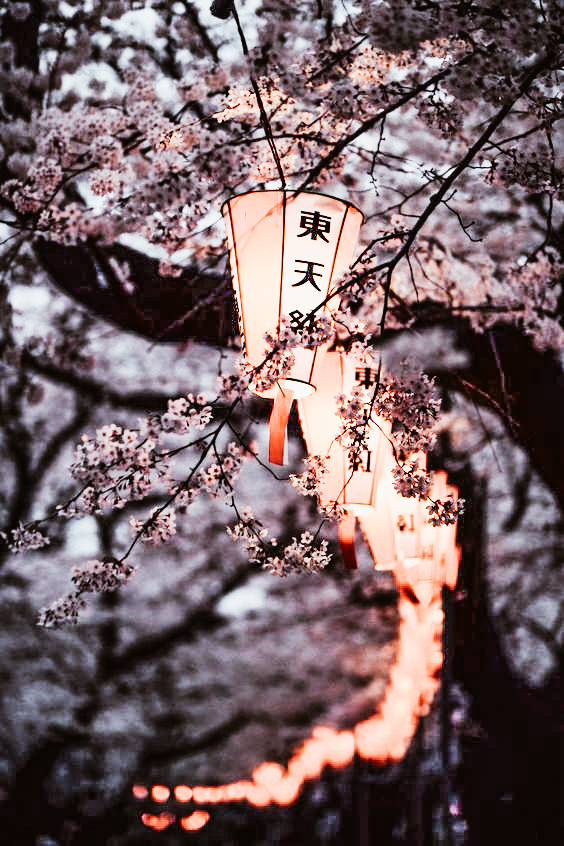
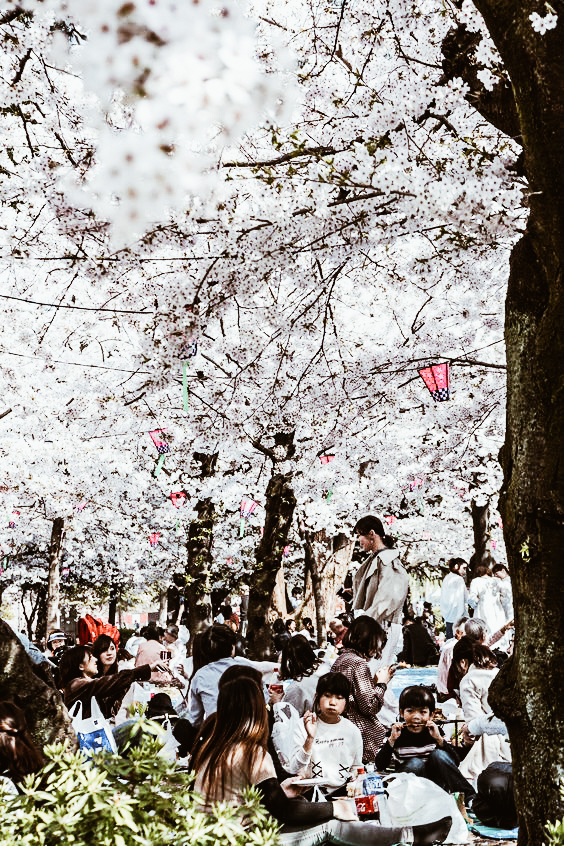
photo credits: Pinterest, Pinterest
Sakura in sweets and delicacies
Sakura and spring are also celebrated through food, in keeping with good Japanese tradition. Famous is the Hanami Bentō (花見弁当), or the bentō that is a must during a picnic under the cherry blossoms. For those who don't know, the bentō is a box for a picnic lunch, used by the Japanese all year round, but in this period it has a Sakura theme. You might find Sakura Onigiri (桜おにぎり) in there, for example, rice balls with salted Sakura on top.
However, there is also cherry blossom tea (桜茶, Sakura-cha), possibly combined with Sakura-Mochi (桜餅), a typical rice cake with red bean paste, wrapped in a salted cherry leaf. Sakura infusion is offered to newlyweds on their wedding day as it is considered a good omen. Wagashi (和菓子) - the traditional Japanese confectionery - come in a variety of sakura-themed varieties. Again, among the more commercial products: just as you can have Matcha-milk, there is also an all-pink Sakura-milk. And we could go on and on, but perhaps we'd better stop, otherwise our mouths will water too much!


photo credits: kitchenbook.jp, pinterest.fr
Hanami (花見), admire the buds
Hanafubuki (花吹雪): "snowy storm of buds". This is how the spectacle of falling petals from cherry trees in bloom is defined, whose rain colours the landscape in a kind of "spring snowfall". If one of these petals (花びら- Hanabira) falls into one's sake glass while making Hanami, it is a propitiatory sign of good health.
As mentioned at the beginning, the word "Hanami" means the practice of looking at cherry blossoms (花= flower(s), 見= watching). Nowadays, Hanami celebrations can range from simple picnics to more elaborate celebrations with music and entertainment. They can also take place at night, in which case, we talk about Yozakura (夜桜) or "sakura by night". The result, you can imagine: an evocative nocturnal Hanami, amid paper lanterns and moonlight.
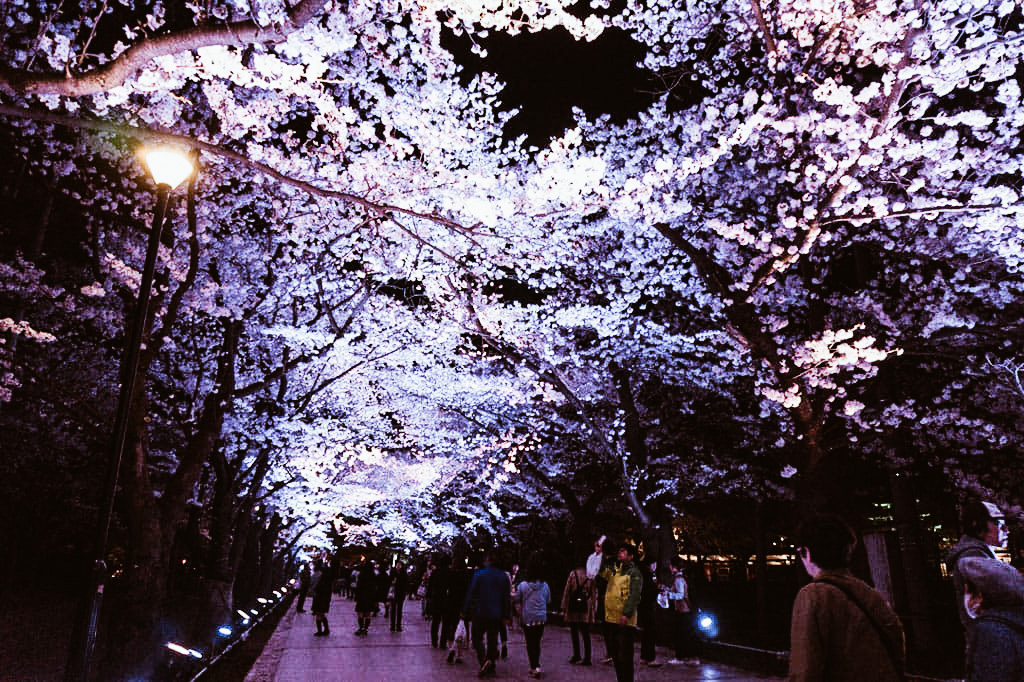
photo credits: power-shower.com
However, the peculiarity of Hanami is not in simply witnessing this spectacle of nature: it is in assisting it by capturing its fleeting appearance. The beauty of the buds also lies in their transience. In those who contemplate them, a feeling of sweet melancholy arises... which the delicacy of these flowers is able to evoke when, having detached themselves from the tree, they float carried by the wind or a delicate breeze, to then settle on the ground. An emotion given by the realisation that this is nothing other than the ultimate nature of human existence itself: destined, sooner or later, to have an end.
"So I come to this place with my ancestors and a thought comes back to me: like these sprouts we are all dying... recognising life in every breath, in every cup of tea, in every life we take away... " [ Katsumoto Moristugu - The Last Samurai ]
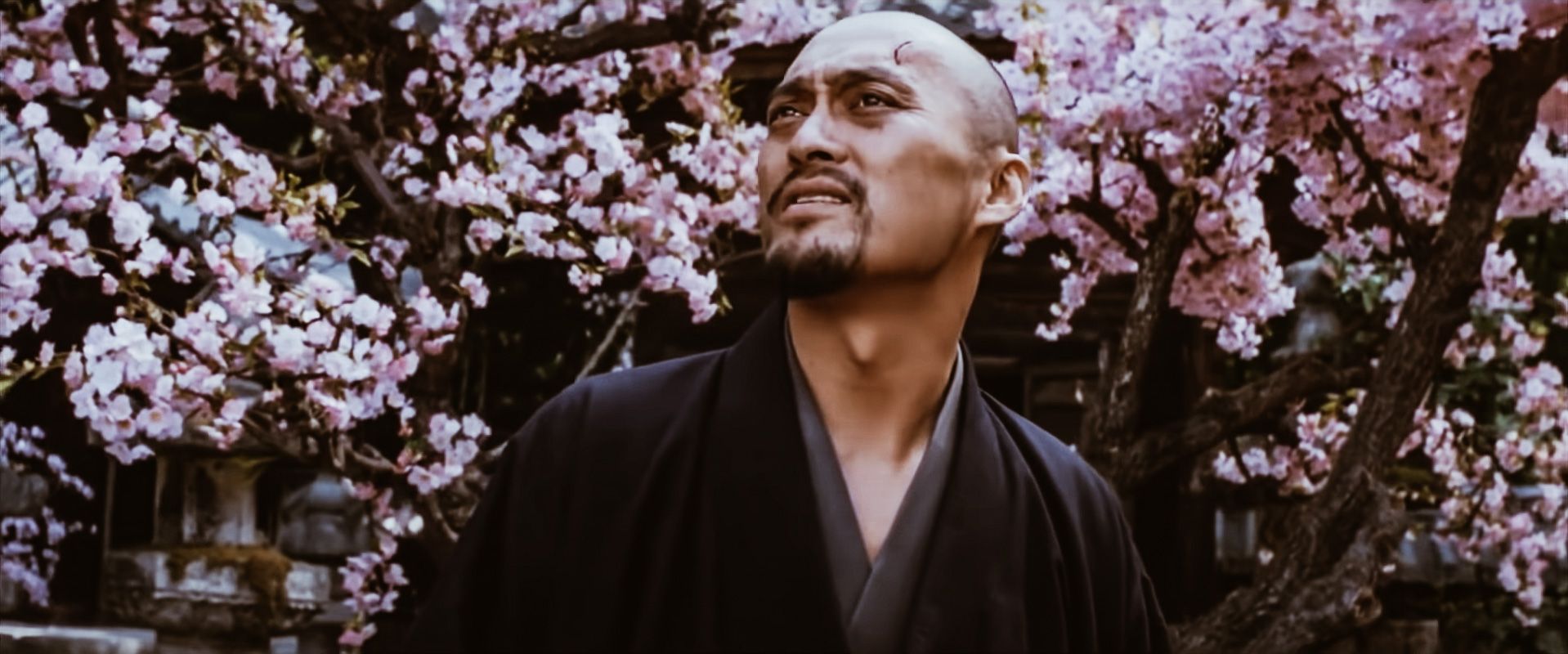
photo credits: YouTube
Symbolism of Sakura: mono no aware (物の哀れ)
The symbolism of Sakura is therefore both sweet and bitter, but this should not surprise us, as we are familiar with the Japanese feeling of "Mono no aware". In other words, a "pathos for things" characterised by a delicate hint of nostalgia, due to the awareness of their constant change. A concept that our Sakura embodies to perfection and of which he inevitably becomes the spokesman. Its beauty is enchanting but evanescent, ephemeral. So contemplation becomes sweet because of the delicacy of the flower, but also melancholic... because it is aware of its evanescence. Thus we contemplate its splendour but with an aftertaste of sadness. In a few words, this is the essence of Sakura.
Once again we are faced with an aesthetic that transcends the exterior. An exterior whose beauty hooks individuals, then leads them to a wider form of contemplation. We have seen this well, also in our article dedicated to Wabi-Sabi 侘寂. This has never been more true than in the case of the Sakura.
Cherry blossoms thus symbolise the transience of life and cyclicity. Because they blossom in all their glory, but their show remains for a limited time. The transience of life, youth and beauty: a metaphor that nature itself seems to want to offer every year and which Japan has been particularly careful to capture. At the same time, however, they are also a symbol of (re)birth and hope... because every year they come back to bloom in all their splendour.
Wonderful and a symbol of vitality on the one hand, extremely fragile on the other: this is their dual nature. Given this awareness, the reference to Buddhism is inevitable.
Symbolism of Sakura: other meanings
Other more specific meanings attributed to Sakura have to do with the number 5. So, naturally, it is the classic five-petalled cherry tree that best lends itself to this type of symbolism. The number 5 is said to recall the Japanese cosmogonic myth (about the birth of the 'cosmos'), according to which there were originally two gods, Izanagi and Izanami, who fathered five children; the birth of the fifth child, the god of fire, would prove fatal to the mother-goddess Izanami. Izanagi, distraught, thus killed this son, from whose parts the mountain gods would then originate. The number 5 also refers to the Japanese esoteric Buddhist concept of the five orientations (cardinal points plus the centre) and the five elements of water, fire, earth, ether and vacuum.
More generally, cherry trees can also be associated with clouds simply because of a visual issue: their mass blossoming can be reminiscent of clouds in the sky. A bit like the expression 'Hanafubuki' we saw earlier, where fubuki (吹雪) alone means 'snowstorm'.
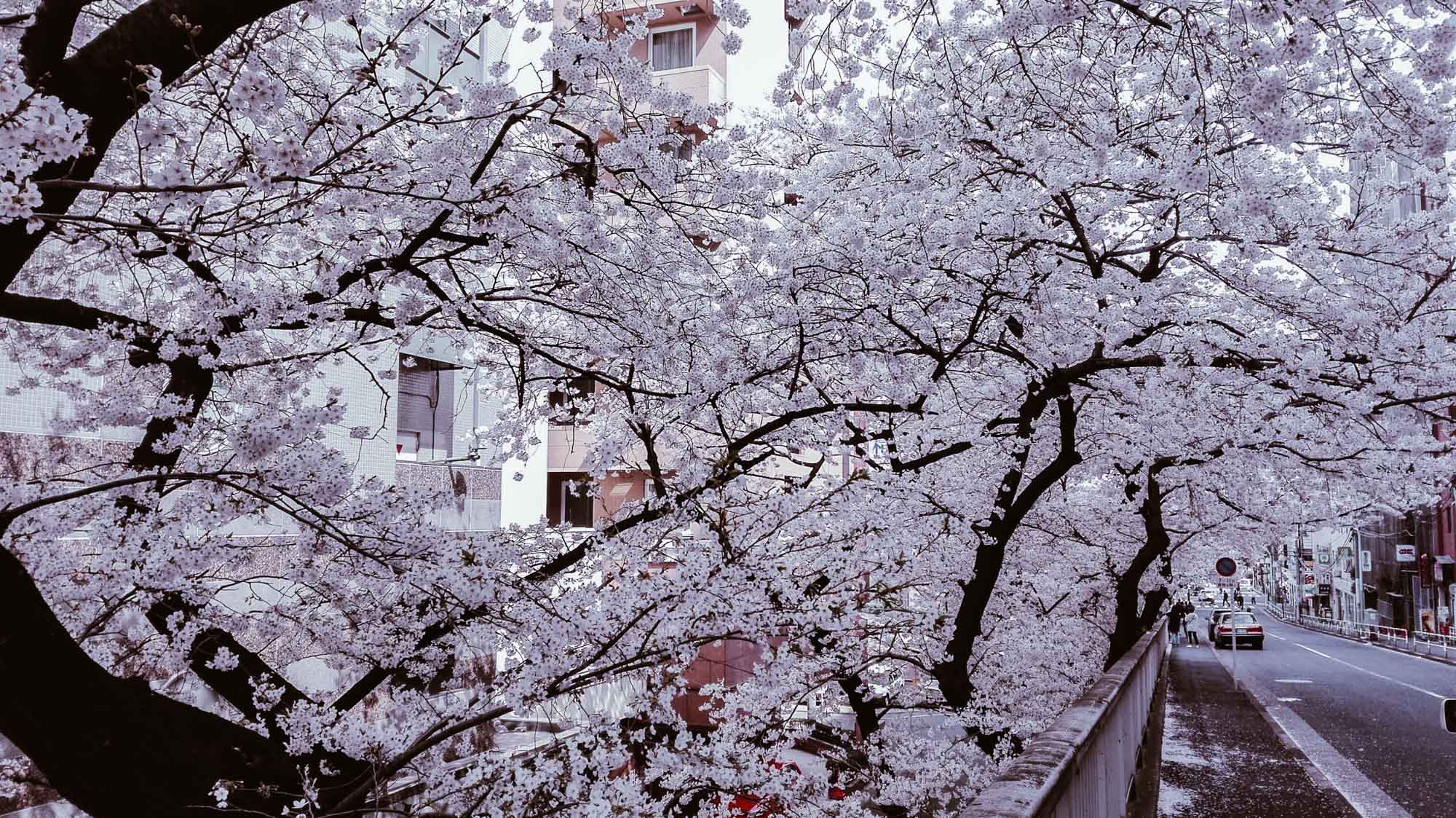
photo credits: Flavia
As the Sakura, so the Samurai
But back to our Katsumoto-Watanabe, his sentence actually ended with "...this is Bushidō". In fact, Sakura was also associated with the ideal of the way of the warrior and the figure of the samurai (侍), so much so that it became the emblem of the category. You will say, where is the similarity? In the fact that the cherry blossom embodied the qualities typically associated with the samurai (courage, purity, honesty, loyalty...). As the Sakura dies at the height of its splendour, so the samurai at the height of his vitality and strength was ready to die if the time came. In this sense, his life, however grand, was as fragile as that of a cherry blossom. However, he was not afraid of death, since it was experienced as a last ideal act and the only possible honourable end, in the name of extreme loyalty to his values.
In the cherry tree, the bushi (warrior) found his model and identified his life with it. Just like the delicate little flower, he had to lead his existence giving his all, through dedication in every gesture, until his last sigh. All that mattered was to "burn" as much as possible through that fuel, which was his life force. In all this, there could be no room for the fear of death. On the contrary, it was in the warrior's last moments that his beauty shone brightest.
So the Sakura, so the bushi: just like in the proverb "Hana wa sakura-gi, hito wa bushi" ( 花は桜木-人は武士 ) that is "Among the flowers the cherry tree, among the people the warrior". The samurai in battle could fall under the blows of the opponent, just like buds that fall to the ground detached from the branches by a gust of wind or rain. Just like so many small, triumphant buds, the samurai flourished, only to meet their fate.
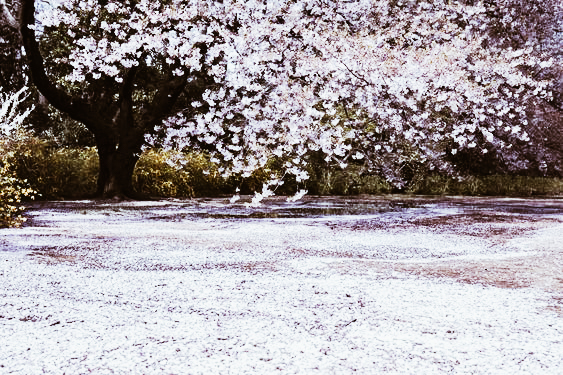
photo credits: Pinterest
This identification was also used in various ways by Imperial Japan centuries later. Among others: the Sakura was reproduced on the sides and in the name itself of the Ōka ( 桜花 ) airplanes to symbolise the extreme act of the Tokkōtai (Special Attack Unit) Kamikaze at the end of World War II. The pilots themselves, on the verge of their suicide mission, are said to have embarked carrying a cherry branch.
Nowadays, the Sakura may symbolise the martial arts.
"Woman sitting under the cherry blossom trees"
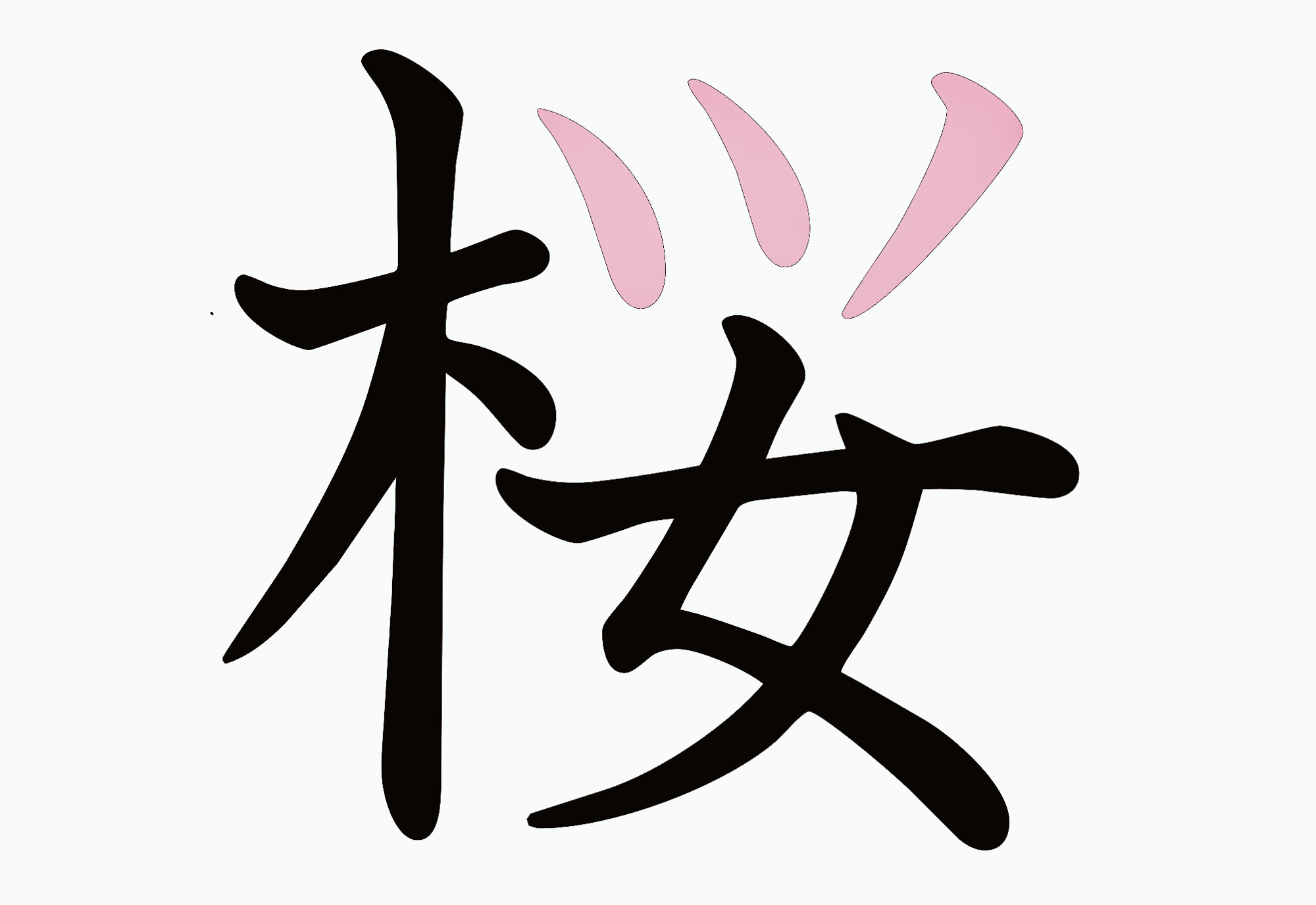
photo credits: appareassociazione.blogspot.com
This is the image that could be drawn - certainly the one I see - by observing the ideogram of "sakura". This is far from being the explanation why the kanji 桜 has this specific form, but it lends itself well to such an interpretation. Especially given its present simplified form. Before leaving us, we cannot conclude without a parenthesis on the writing and the cherry tree kanji.
As you can see in the picture above, Sakura's ideogram 桜 is composed on the left of the radical 木 (=tree), on the right of three dashes with the character 女 (=woman) below. The little part in pink, tell the truth: doesn't it really resemble the petals of a flower?
Actually, this part used to be written in a more elaborate way and had nothing to do with the meaning. It was written like this: 櫻. Later on, it underwent a process of simplification, like so many other ideograms in both Japan and China (where they come from). Bearing in mind that ideograms derive from pictograms, let us observe our character in its transition from pictogram to ideogram in the images below.

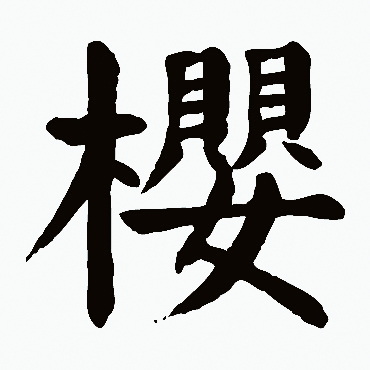
photo credits: shufam.hao86.com, shufa.m.supfree.net
This was its transition, and then in more modern times it changed exactly as follows: 櫻 🡪 桜 (in China it became 🡪 樱 ). The double 貝貝, which preceded the present three hyphens, indicated "necklace"; while the single 貝 still means "shell". So you see how, by investigating the Chinese etymology, the real historical evolution is revealed. Be careful, however, because the whole right-hand side (i.e. 嬰) of the ideogram 櫻 has reason to be there solely for a phonetic reason. (Not for reasons of meaning, which is also different between Chinese and Japanese). That is, that part has been "put" there to give the pronunciation to the kanji 櫻 as a whole.
But beyond this brief digression, we still like to see it like this: like a little woman under a flowering tree. Right? Since we are dealing with the simplified character today, we can safely indulge in this reading of the kanji which, coincidentally, is very reminiscent of the image of a woman under the blossoming cherry trees. And it certainly helps a lot to remember the ideogram. After all, this flower also recalls femininity. It is no coincidence that Sakura, or the variant Sakurako (桜子or 櫻子), are quite common female names in Japan.
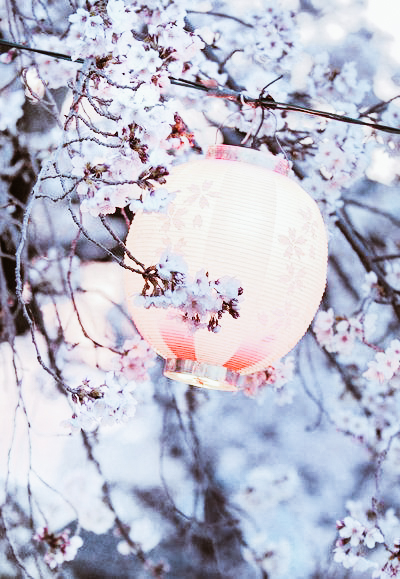
photo credits: pinterest.it
Guardians of Japan - Episode 01: "Age of Samurai: Battle for Japan" review
Here we are again with a new web series by Japan Italy Bridge! As you know, we aim to communicate and promote Japanese culture and companies in Italy and vice versa.
Since it is not possible to travel in this period, we have decided to try to shorten the distance between Italy and Japan even more by telling you not only about our experiences but also by sharing what we know about the Land of the Rising Sun.
We have already produced a web series dedicated to the promotion of Japan here in Italy called "Bringing Japan to Italy" and now we start with this new series dedicated to the history of Japan and mainly to those figures that fascinate us Westerners: the Samurai. For those who have been following us for some time, you already know that we have a fairly rich column on this subject on our blog and now we have decided to delve into it all through a video podcast.
So at each episode we are going to analyse the life and adventures of Japan's most important Samurai and we decided to dedicate the first episode to the review of the TV series "Age of Samurai: Battle for Japan" that you can find streaming on Netflix! We had already anticipated the arrival of "Age of Samurai" on Netflix and now after a full immersion we are ready to tell you what it is about, our impressions and also some curiosities!
We hope you enjoy this first episode and we are really curious to receive your feedback. Stay tuned because in the next episodes not only will you be able to discover the true history of Japan, but there will also be many surprises waiting for you, enjoy!
Authors: Erika Panzeri, Angie Antenucci // Japan Italy Bridge
Editing: Erika Panzeri // Japan Italy Bridge
Some of the footage in the video is owned by Netflix, we do not claim property of that footage.
Japan History: Azai Nagamasa
Azai Nagamasa (1545 - 26 September 1573) was a Japanese daimyō, son of Azai Hisamasa, from whom he inherited the leadership of the clan in 1560 when Hisamasa was forced to step down in favour of his son.
Azai Nagamasa, the head of the clan Azai
Autore: SaiKaiAngel
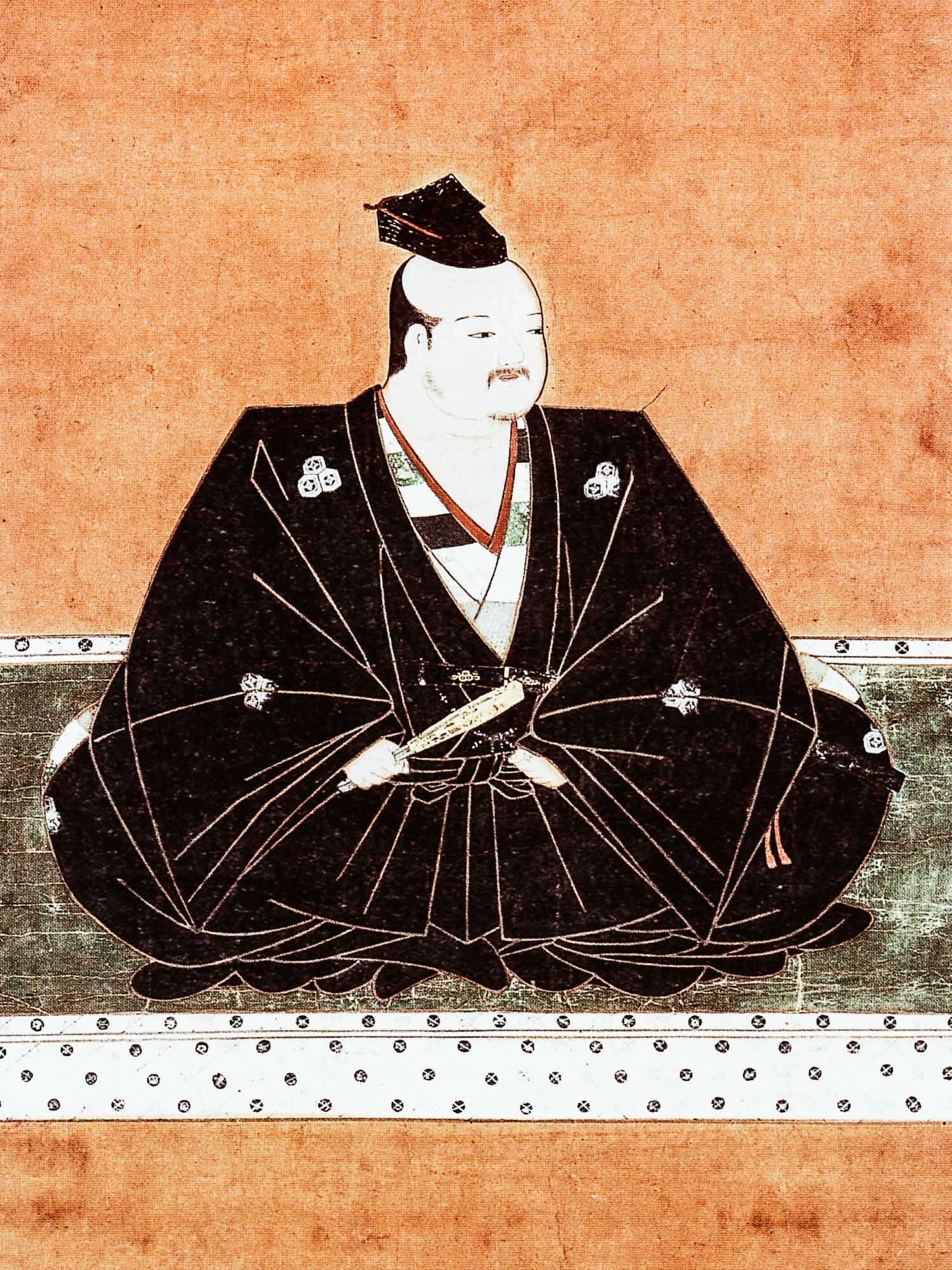
photo credits: wikipedia.org
Nagamasa became one of Nobunaga's enemies in 1570 due to the Azai's alliance with the Asakura clan, fighting against him in important battles including the Battle of Anegawa. Nagamasa and his clan were destroyed by Nobunaga in August 1573, and he committed seppuku during the siege of Odani Castle.
Conflict with Oda Nobunaga
Not only the arch-enemy of Oda Nobunaga, Azai Nagamasa also became his brother-in-law, as he married his sister Oichi in 1564. Oda Nobunaga sought to establish relations with the Azai clan because of their strategic position between the lands of the Oda clan and the capital, Kyoto.
The great conflict began when in 1570, Oda Nobunaga declared war on the Asakura family by besieging Kanegasaki castle. The Asakura and the Azai had been allies since ancient times. In this war, contrary to many who wanted to honour the alliance with the Asakuras, Nagamasa preferred to remain neutral, siding with Nobunaga. In the end, the Azai clan chose to honour their ancient alliance with the Asakura and came to their aid. Therefore Nobunaga's army, which was marching on the Asakura lands, retreated towards Kyoto. However, within a few months Nobunaga's forces were on the march again, but this time they marched on the Azai lands.
The Battle of Anegawa
In the summer of 1570, Oda Nobunaga returned to attack with Tokugawa Ieyasu and an army of around 30,000 men in Omi province against the Azai and Asakura. The Battle of Anegawa took place on two fronts, Oda against Azai, Tokugawa against Asakura. Although outnumbered, Nagamasa's troops managed to hold off the Oda troops and it seemed as if victory was assured, but when Tokugawa Ieyasu came to Nobunaga's aid after defeating the Asakuras, the situation was reversed.
Death
Over the next two years the Azai were under constant attack from the Oda, who came to besiege the castle of the capital, Odani in 1573 in the famous Siege of Odani. It is during this period that the Azai are seen to be loosely aligned with numerous anti-Oda forces, including the Asakura, Miyoshi, Rokkaku and various religious complexes.
With no way out, Nagamasa carried out seppuku in August 157e along with his father Hisamasa, sending Oichi and his three daughters to Nobunaga who decided to spare them. This did not happen with Nagamasa's only male heir, Manpukumaru, who was executed by General Toyotomi Hideyoshi on Nobunaga's orders.
Oda Nobunaga made sure that his sister, Oichi, was not informed of this, but she eventually came to this suspicion.
It seems that Nobunaga harboured a strong grudge against Nagamasa because of his alleged treachery, although it was he who broke the agreement first. It is also said that Nobunaga had the skulls of Nagamasa, Hisamasa and the Asakura chief lacquered so that they could be used as mugs, but this fact is not only not historically accurate, but could also be invented to further discredit Nobunaga's reputation.

photo credits: wikipedia.org
It should be added that Nagamasa's three daughters were of great importance, starting with the fact that they married very famous men:
- Chacha, or Yodo dono, was the second wife of Toyotomi Hideyoshi and mother of his heir Hideyori.
- Hatsu, married daimyo Kyōgoku Takatsugu.
- Oeyo, or Sūgen'in, was the wife of the second Tokugawa shōgun, Hidetada, and mother of his successor Iemitsu.







